Paul van Yperen's Blog, page 327
November 18, 2016
Imported from the USA: Bebe Daniels
Bebe Daniels (1901-1971) was an American actress, singer, dancer, writer and producer. She began her career in Hollywood during the silent film era as a child actress and later, she was the love interest of Harold Lloyd in dozens of short comedies. Cecil B. de Mille made her a silent star and she also sang and danced in early musicals like Rio Rita (1929) and 42nd Street (1933). In Great Britain, she gained further fame on stage, radio and television. In her long career, Bebe Daniels appeared in 230 films.

French postcard by Cinémagazine Edition, Paris, no. 452. Photo: Paramount.

German postcard by Ross Verlag, no. 4811/1, 1929-1930. Photo: RKO Radio Pictures. Collection: Geoffrey Donaldson Institute.

French postcard, no. 290.
Charming and spunky
Phyllis Virginia Daniels was born in Dallas, Texas, in 1901. Bebe was her childhood nickname. Her father was a theatre manager and her mother was stage and silent film actress Phyllis Daniels. The family moved to Los Angeles, California in her childhood and she began her acting career at the age of four in the stage play The Squaw Man.
That same year she also went on tour in a stage production of William Shakespeare's Richard III. The following year she participated in productions by Oliver Morosco and David Belasco.
By the age of eight Daniels made her film debut as the young heroine in A Common Enemy (Otis Turner, 1910). Then she starred as Dorothy Gale in the short The Wonderful Wizard of Oz (Otis Turner, 1910). It is the earliest surviving film version of L. Frank Baum's 1900 novel The Wonderful Wizard of Oz, made by the Selig Polyscope Company. It was later followed by the sequels Dorothy and the Scarecrow in Oz (1910), The Land of Oz (1910) and John Dough and the Cherub (1910), all considered to be lost films.
At the age of fourteen Bebe was enlisted by studio head Hal Roach to pair her with very young and talented Harold Lloyd and also Snub Pollard in a series of two-reel comedies starting with Giving Them Fits (Hal Roach, 1915). At the time, Harold Lloyd was trying to ape Charlie Chaplin in his character, 'Lonesome Luke'. Roach made 80 short comedies featuring Harold as Luke with Bebe playing his love interest between 1915 and 1917, including Bughouse Bellhops (Hal Roach, 1915), Tinkering with Trouble (Hal Roach, 1915) and Ruses, Rhymes and Roughnecks (Hal Roach, 1915).
Lloyd and the charming and spunky Daniels eventually became known as ‘The Boy and The Girl’ in such shorts as Bliss (Alfred J. Goulding, 1917), The Non-stop Kid (Gilbert Pratt, 1918) and Young Mr. Jazz (Hal Roach, 1919). Stephan Eichenberg at IMDb : “Lloyd fell hard for Bebe and seriously considered marrying her, but her drive to pursue a film career along with her sense of independence clashed with Lloyd's Victorian definition of a wife.”
After 200 shorts for Hal Roach Studios. Bebe decided to move to greater dramatic roles and accepted a contract from Cecil B. DeMille in 1919. He gave her secondary roles in such feature films as Male and Female (Cecil B. DeMille, 1919) starring Gloria Swanson , Why Change Your Wife? (Cecil B. DeMille, 1920), and The Affairs of Anatol (Cecil B. DeMille, 1921), with Wallace Reid.

Italian postcard, no. 166. Photo: publicity still for Why Change Your Wife? (Cecil B. DeMille, 1920).

British postcard. Photo: publicity still for The Speed Girl (Maurice Campbell, 1921).

German postcard by Ross Verlag, no. 4812/1, 1929-1930. Photo: Radio Pictures (RKO). Publicity still for Rio Rita (Luther Reed, 1929) with John Boles.
A 20-year-old veteran film actress
In the 1920s, Bebe Daniels was under contract with Paramount Pictures, and made the transition from child star to adult in Hollywood. The now lost comedy The Speed Girl (Maurice Campbell, 1921) was supposedly expanded into a screenplay from Daniels's real life jail sentence of 10 days for multiple speeding tickets. The film poster shows her walking out of a jail cell.
At the time the 20-year-old was already a veteran film actress. By 1924 Bebe was playing Rudolph Valentino’s love interest in the costume drama Monsieur Beaucaire (Sidney Olcott, 1924). Paramount spared no expense on the film from the sets, costumes down to the musical soundtrack that accompanied it upon it's release.
Following this she was cast in a number of light popular films, namely Miss Bluebeard (Frank Tuttle, 1925), The Manicure Girl (Frank Tuttle, 1925), and Wild Wild Susan (A. Edward Sutherland, 1925) with Rod LaRocque.
Paramount dropped her contract with the advent of talking pictures. Daniels was hired by Radio Pictures (later known as RKO) to star opposite John Boles in one of their biggest productions of the year, the talkie Rio Rita (Luther Reed, 1929). Its finale was photographed in two-colour Technicolor.
The musical comedy, based on the 1927 stage musical produced by legendary showman Florenz Ziegfeld, proved to be the studio's biggest box office hit until King Kong (Merian C. Cooper, Ernest B. Schoedsack, 1933). Daniels found herself a star and RCA Victor hired her to record several records for their catalogue. Radio Pictures starred her in lavish musicals such as Dixiana (Luther Reed, 1930) and Love Comes Along (Rupert Julian, 1930).

German postcard by Ross Verlag, no. 51592, 1930-1931. Photo: Radio Pictures (RKO). Publicity still for Rio Rita (Luther Reed, 1929) with John Boles.

German postcard by Ross Verlag, no. 5158/1, 1930-1931. Photo: Radio Pictures (RKO). Publicity still for Love Comes Along (Rupert Julian, 1930) with Lloyd Bridges.

Austrian postcard by Iris Verlag, no. 368-3. Photo: Paramount-Film.

French postcard by Europe, no. 379. Photo: Paramount.
Box office draw
Toward the end of 1930, Bebe Daniels appeared opposite Douglas Fairbanks in the musical comedy Reaching for the Moon (Edmund Goulding, 1930). However, by this time musicals had gone out of fashion so that most of the musical numbers from the film had to be removed before it could be released.
Daniels had become associated with musicals and so Radio Pictures did not renew her contract. Warner Bros. realised what a box office draw she was and offered her a contract which she accepted. During her years at Warner Bros. she starred in such pictures as the drama My Past (Roy Del Ruth, 1931), Honor of the Family (Lloyd Bacon, 1931) and the pre-code version of The Maltese Falcon (Roy Del Ruth, 1931).
The Maltese Falcon was based on the novel of the same name by Dashiell Hammett and starred Ricardo Cortez as Sam Spade. It was a huge success for Warner and garnered rave reviews for Bebe and Cortez.
In 1932, she appeared opposite Edward G. Robinson in Silver Dollar (Alfred E. Green, 1932) and the successful Busby Berkeley choreographed musical extravaganza 42nd Street (Lloyd Bacon, 1933) in which she played the star of a stage musical who breaks her ankle. The backstage musical was nominated for the Academy Award for Best Picture.
That same year Daniels played opposite John Barrymore in the enjoyable Counsellor at Law (William Wyler, 1933). The film was another box office smash. Her last film for Warner Bros. was Registered Nurse (Robert Florey, 1934).
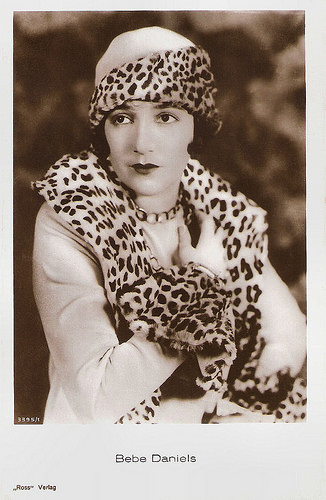
German postcard by Ross Verlag, no. 3395/1, 1928-1929.

German postcard. Ross Verlag, no. 4003/1, 1929-1930. Photo: Paramount.

German postcard. Ross Verlag, no. 4109/1, 1929-1930. Photo: Paramount.

German postcard by Ross Verlag, no. 6498/1, 1931-1932. Photo: First National Pictures. Publicity still for Honor of the Family (Lloyd Bacon, 1931).
Hi Gang!
Bebe Daniels retired from Hollywood in 1935. By then, she had been a working actress for 30 years. With her husband, film actor Ben Lyon, whom she had married in 1930, she moved to London. Daniels and Lyon had two children: daughter Barbara (1932) and a son Richard whom they had adopted.
In England, they had found a quiet place in the countryside to raise their family. They starred in the British comedy crime film Treachery on the High Seas (Emil E. Reinert, 1936) with Charles Farrell. They also wanted to go back to the theatre.
A few years later, Daniels starred in the London production of Panama Hattie in the title role originated by Ethel Merman. The Lyons then did radio shows for the BBC. Most notably, they starred in the radio series Hi Gang!, continuing for decades and enjoying considerable popularity during World War II. Daniels wrote most of the dialogue for the Hi Gang radio show. There was also the spin-off film Hi Gang! (Marcel Varnel, 1941) in which they starred opposite Vic Oliver .
The couple stayed in London, broadcasting even during the worst days of The Blitz of WW II. Ben signed up for the Royal Air Force while Bebe kept the home fires burning in between appearing in the occasional stage play. Following the war, Daniels was awarded the Medal of Freedom by Harry S. Truman for war service.
In 1945 she returned to Hollywood for a short time to work as a film producer for Hal Roach and Eagle-Lion Films. She returned to the UK in 1948 and lived there for the remainder of her life. Daniels, her husband Ben, her son Richard and her daughter Barbara all starred in the radio sitcom Life With The Lyons (1951-1961), which later made the transition to two films and to television (1955-1960). Daniels’ final film was The Lyons in Paris (Val Guest, 1955).
Bebe Daniels suffered a severe stroke in 1963 and withdrew from public life. She suffered a second stroke in late 1970. In 1971, Daniels died of a cerebral hemorrhage in London at the age of 70. Her ashes would eventually be interred at the Hollywood Forever Cemetery in Hollywood California. Upon his death in 1979, Ben Lyon's remains were interred next to Daniels'.
Trailer Rio Rita (1929). Source: perfectjazz78 (YouTube).
Scene from The Maltese Falcon (1931) with Ricardo Cortez as Sam Spade, Una Merkel as Effie Perine and Bebe Daniels as Ruth Wonderly. Source: egosomnio (YouTube).
Trailer 42nd Street (1933). Source: Victoria Mentz (YouTube).
Sources: (IMDb), Page (My Love of Old Hollywood), Shawn Dwyer (TCM), Wikipedia, and .

French postcard by Cinémagazine Edition, Paris, no. 452. Photo: Paramount.

German postcard by Ross Verlag, no. 4811/1, 1929-1930. Photo: RKO Radio Pictures. Collection: Geoffrey Donaldson Institute.

French postcard, no. 290.
Charming and spunky
Phyllis Virginia Daniels was born in Dallas, Texas, in 1901. Bebe was her childhood nickname. Her father was a theatre manager and her mother was stage and silent film actress Phyllis Daniels. The family moved to Los Angeles, California in her childhood and she began her acting career at the age of four in the stage play The Squaw Man.
That same year she also went on tour in a stage production of William Shakespeare's Richard III. The following year she participated in productions by Oliver Morosco and David Belasco.
By the age of eight Daniels made her film debut as the young heroine in A Common Enemy (Otis Turner, 1910). Then she starred as Dorothy Gale in the short The Wonderful Wizard of Oz (Otis Turner, 1910). It is the earliest surviving film version of L. Frank Baum's 1900 novel The Wonderful Wizard of Oz, made by the Selig Polyscope Company. It was later followed by the sequels Dorothy and the Scarecrow in Oz (1910), The Land of Oz (1910) and John Dough and the Cherub (1910), all considered to be lost films.
At the age of fourteen Bebe was enlisted by studio head Hal Roach to pair her with very young and talented Harold Lloyd and also Snub Pollard in a series of two-reel comedies starting with Giving Them Fits (Hal Roach, 1915). At the time, Harold Lloyd was trying to ape Charlie Chaplin in his character, 'Lonesome Luke'. Roach made 80 short comedies featuring Harold as Luke with Bebe playing his love interest between 1915 and 1917, including Bughouse Bellhops (Hal Roach, 1915), Tinkering with Trouble (Hal Roach, 1915) and Ruses, Rhymes and Roughnecks (Hal Roach, 1915).
Lloyd and the charming and spunky Daniels eventually became known as ‘The Boy and The Girl’ in such shorts as Bliss (Alfred J. Goulding, 1917), The Non-stop Kid (Gilbert Pratt, 1918) and Young Mr. Jazz (Hal Roach, 1919). Stephan Eichenberg at IMDb : “Lloyd fell hard for Bebe and seriously considered marrying her, but her drive to pursue a film career along with her sense of independence clashed with Lloyd's Victorian definition of a wife.”
After 200 shorts for Hal Roach Studios. Bebe decided to move to greater dramatic roles and accepted a contract from Cecil B. DeMille in 1919. He gave her secondary roles in such feature films as Male and Female (Cecil B. DeMille, 1919) starring Gloria Swanson , Why Change Your Wife? (Cecil B. DeMille, 1920), and The Affairs of Anatol (Cecil B. DeMille, 1921), with Wallace Reid.

Italian postcard, no. 166. Photo: publicity still for Why Change Your Wife? (Cecil B. DeMille, 1920).

British postcard. Photo: publicity still for The Speed Girl (Maurice Campbell, 1921).

German postcard by Ross Verlag, no. 4812/1, 1929-1930. Photo: Radio Pictures (RKO). Publicity still for Rio Rita (Luther Reed, 1929) with John Boles.
A 20-year-old veteran film actress
In the 1920s, Bebe Daniels was under contract with Paramount Pictures, and made the transition from child star to adult in Hollywood. The now lost comedy The Speed Girl (Maurice Campbell, 1921) was supposedly expanded into a screenplay from Daniels's real life jail sentence of 10 days for multiple speeding tickets. The film poster shows her walking out of a jail cell.
At the time the 20-year-old was already a veteran film actress. By 1924 Bebe was playing Rudolph Valentino’s love interest in the costume drama Monsieur Beaucaire (Sidney Olcott, 1924). Paramount spared no expense on the film from the sets, costumes down to the musical soundtrack that accompanied it upon it's release.
Following this she was cast in a number of light popular films, namely Miss Bluebeard (Frank Tuttle, 1925), The Manicure Girl (Frank Tuttle, 1925), and Wild Wild Susan (A. Edward Sutherland, 1925) with Rod LaRocque.
Paramount dropped her contract with the advent of talking pictures. Daniels was hired by Radio Pictures (later known as RKO) to star opposite John Boles in one of their biggest productions of the year, the talkie Rio Rita (Luther Reed, 1929). Its finale was photographed in two-colour Technicolor.
The musical comedy, based on the 1927 stage musical produced by legendary showman Florenz Ziegfeld, proved to be the studio's biggest box office hit until King Kong (Merian C. Cooper, Ernest B. Schoedsack, 1933). Daniels found herself a star and RCA Victor hired her to record several records for their catalogue. Radio Pictures starred her in lavish musicals such as Dixiana (Luther Reed, 1930) and Love Comes Along (Rupert Julian, 1930).

German postcard by Ross Verlag, no. 51592, 1930-1931. Photo: Radio Pictures (RKO). Publicity still for Rio Rita (Luther Reed, 1929) with John Boles.

German postcard by Ross Verlag, no. 5158/1, 1930-1931. Photo: Radio Pictures (RKO). Publicity still for Love Comes Along (Rupert Julian, 1930) with Lloyd Bridges.

Austrian postcard by Iris Verlag, no. 368-3. Photo: Paramount-Film.

French postcard by Europe, no. 379. Photo: Paramount.
Box office draw
Toward the end of 1930, Bebe Daniels appeared opposite Douglas Fairbanks in the musical comedy Reaching for the Moon (Edmund Goulding, 1930). However, by this time musicals had gone out of fashion so that most of the musical numbers from the film had to be removed before it could be released.
Daniels had become associated with musicals and so Radio Pictures did not renew her contract. Warner Bros. realised what a box office draw she was and offered her a contract which she accepted. During her years at Warner Bros. she starred in such pictures as the drama My Past (Roy Del Ruth, 1931), Honor of the Family (Lloyd Bacon, 1931) and the pre-code version of The Maltese Falcon (Roy Del Ruth, 1931).
The Maltese Falcon was based on the novel of the same name by Dashiell Hammett and starred Ricardo Cortez as Sam Spade. It was a huge success for Warner and garnered rave reviews for Bebe and Cortez.
In 1932, she appeared opposite Edward G. Robinson in Silver Dollar (Alfred E. Green, 1932) and the successful Busby Berkeley choreographed musical extravaganza 42nd Street (Lloyd Bacon, 1933) in which she played the star of a stage musical who breaks her ankle. The backstage musical was nominated for the Academy Award for Best Picture.
That same year Daniels played opposite John Barrymore in the enjoyable Counsellor at Law (William Wyler, 1933). The film was another box office smash. Her last film for Warner Bros. was Registered Nurse (Robert Florey, 1934).

German postcard by Ross Verlag, no. 3395/1, 1928-1929.

German postcard. Ross Verlag, no. 4003/1, 1929-1930. Photo: Paramount.

German postcard. Ross Verlag, no. 4109/1, 1929-1930. Photo: Paramount.

German postcard by Ross Verlag, no. 6498/1, 1931-1932. Photo: First National Pictures. Publicity still for Honor of the Family (Lloyd Bacon, 1931).
Hi Gang!
Bebe Daniels retired from Hollywood in 1935. By then, she had been a working actress for 30 years. With her husband, film actor Ben Lyon, whom she had married in 1930, she moved to London. Daniels and Lyon had two children: daughter Barbara (1932) and a son Richard whom they had adopted.
In England, they had found a quiet place in the countryside to raise their family. They starred in the British comedy crime film Treachery on the High Seas (Emil E. Reinert, 1936) with Charles Farrell. They also wanted to go back to the theatre.
A few years later, Daniels starred in the London production of Panama Hattie in the title role originated by Ethel Merman. The Lyons then did radio shows for the BBC. Most notably, they starred in the radio series Hi Gang!, continuing for decades and enjoying considerable popularity during World War II. Daniels wrote most of the dialogue for the Hi Gang radio show. There was also the spin-off film Hi Gang! (Marcel Varnel, 1941) in which they starred opposite Vic Oliver .
The couple stayed in London, broadcasting even during the worst days of The Blitz of WW II. Ben signed up for the Royal Air Force while Bebe kept the home fires burning in between appearing in the occasional stage play. Following the war, Daniels was awarded the Medal of Freedom by Harry S. Truman for war service.
In 1945 she returned to Hollywood for a short time to work as a film producer for Hal Roach and Eagle-Lion Films. She returned to the UK in 1948 and lived there for the remainder of her life. Daniels, her husband Ben, her son Richard and her daughter Barbara all starred in the radio sitcom Life With The Lyons (1951-1961), which later made the transition to two films and to television (1955-1960). Daniels’ final film was The Lyons in Paris (Val Guest, 1955).
Bebe Daniels suffered a severe stroke in 1963 and withdrew from public life. She suffered a second stroke in late 1970. In 1971, Daniels died of a cerebral hemorrhage in London at the age of 70. Her ashes would eventually be interred at the Hollywood Forever Cemetery in Hollywood California. Upon his death in 1979, Ben Lyon's remains were interred next to Daniels'.
Trailer Rio Rita (1929). Source: perfectjazz78 (YouTube).
Scene from The Maltese Falcon (1931) with Ricardo Cortez as Sam Spade, Una Merkel as Effie Perine and Bebe Daniels as Ruth Wonderly. Source: egosomnio (YouTube).
Trailer 42nd Street (1933). Source: Victoria Mentz (YouTube).
Sources: (IMDb), Page (My Love of Old Hollywood), Shawn Dwyer (TCM), Wikipedia, and .
Published on November 18, 2016 22:00
November 17, 2016
EFSP's Dazzling Dozen: our newest acquisitions
Last Saturday, we travelled to Utrecht for 'Europe's biggest Vintage Collectors Fair'! And again, we found lots and lots of postcards. In the following months you can see them here at EFSP, but for this post we chose a dozen postcards that dazzled us. So here are 12 favourite acquisitions.

Le petit poucet. French postcard by Croissant, Paris, no. 3662. Photo: Film Pathé. Publicity still for Le petit poucet/Hop o' My Thumb (Vincent Lorent-Heilbron, 1905). Caption: He fell on his knees asking for mercy.

La vie et la passion de Jésus Christ. French postcard. Photo: Film Pathé. Publicity still for La vie et la passion de Jésus Christ (Lucien Nonguet, Ferdinand Zecca, 1903). Caption: The Life of Christ - At the Feet of the Sphinx.

Henri Jourdin de Croix. French postcard. Photo P. Apers. Henri Jourdin de Croix of the Théàtre National de l'Odéon was a French stage actor, director and playwright.
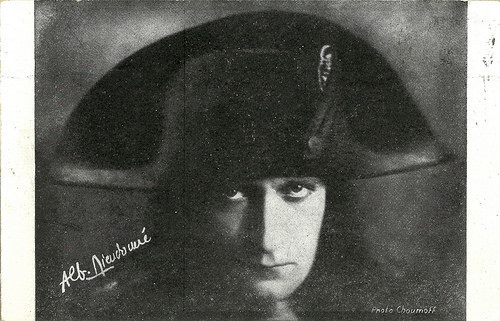
Albert Dieudonné as Napoleon. French postcard. Photo: Choumoff. The retro of the card makes publicity for Dieudonné in a stage version of Bonaparte at the Theatre de la Renaissance.
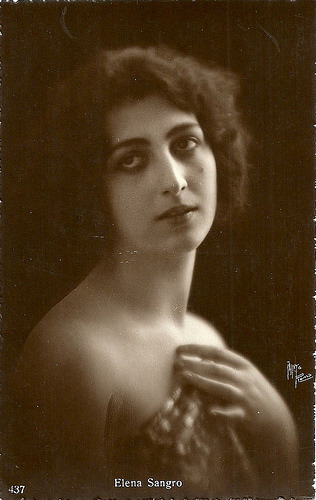
Elena Sangro . Italian postcard by Ed. A. Traldi, Milano. Photo: Pinto, Roma.

Ruth Weyher . German postcard by Ross Verlag, no. 3089/1, 1928-1929. Photo: Atelier Kiesel, Berlin.

Fern Andra . German postcard Ross Verlag, no. 3549/1.Photo: Atelier Schneider.

Greta Garbo in Grand Hotel (1932). Dutch postcard by JosPe, no. 381. Photo: Metro-Goldwyn-Mayer. Publicity still for Grand Hotel (Edmund Goulding, 1932).

Farley Granger and Ruth Roman in Strangers on a Train (1951). Dutch postcard by Takken, no. 566. Photo: Warner Bros. Publicity still for Strangers on a Train (Alfred Hitchcock, 1951).
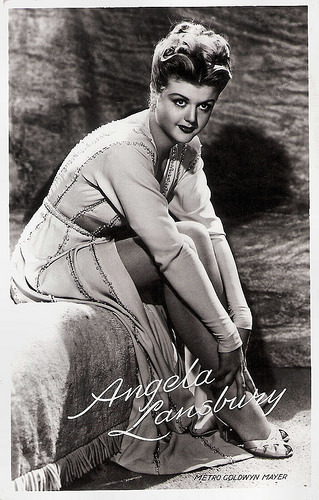
Angela Lansbury. Dutch postcard by Takken, no. 166. Photo: Metro-Goldwyn-Mayer.

Richard Burton and Claire Bloom in Hamlet (1954). Danish postcard by Kaj Brammers Boghandel, Helsingor, no. 748. Photo: publicity still for the stage production of Hamlet at the Hamletspillene in Kronborg, 1954, with Burton as Hamlet and Bloom as Ophelia.
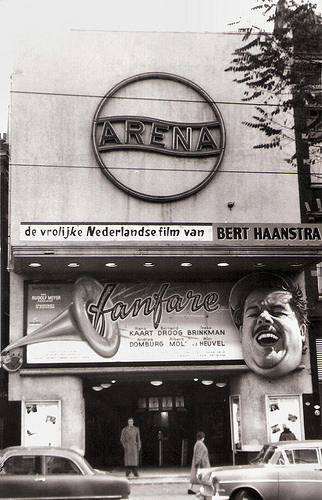
Fanfare at the Arena. Dutch postcard by A. de Herder, Rotterdam. The Arena Cinema was located at the Kruiskade, Rotterdam, The Netherlands. The film on show was the Dutch comedy Fanfare (Bert Haanstra, 1958), starring Hans Kaart.

Le petit poucet. French postcard by Croissant, Paris, no. 3662. Photo: Film Pathé. Publicity still for Le petit poucet/Hop o' My Thumb (Vincent Lorent-Heilbron, 1905). Caption: He fell on his knees asking for mercy.

La vie et la passion de Jésus Christ. French postcard. Photo: Film Pathé. Publicity still for La vie et la passion de Jésus Christ (Lucien Nonguet, Ferdinand Zecca, 1903). Caption: The Life of Christ - At the Feet of the Sphinx.

Henri Jourdin de Croix. French postcard. Photo P. Apers. Henri Jourdin de Croix of the Théàtre National de l'Odéon was a French stage actor, director and playwright.

Albert Dieudonné as Napoleon. French postcard. Photo: Choumoff. The retro of the card makes publicity for Dieudonné in a stage version of Bonaparte at the Theatre de la Renaissance.

Elena Sangro . Italian postcard by Ed. A. Traldi, Milano. Photo: Pinto, Roma.

Ruth Weyher . German postcard by Ross Verlag, no. 3089/1, 1928-1929. Photo: Atelier Kiesel, Berlin.

Fern Andra . German postcard Ross Verlag, no. 3549/1.Photo: Atelier Schneider.

Greta Garbo in Grand Hotel (1932). Dutch postcard by JosPe, no. 381. Photo: Metro-Goldwyn-Mayer. Publicity still for Grand Hotel (Edmund Goulding, 1932).

Farley Granger and Ruth Roman in Strangers on a Train (1951). Dutch postcard by Takken, no. 566. Photo: Warner Bros. Publicity still for Strangers on a Train (Alfred Hitchcock, 1951).

Angela Lansbury. Dutch postcard by Takken, no. 166. Photo: Metro-Goldwyn-Mayer.

Richard Burton and Claire Bloom in Hamlet (1954). Danish postcard by Kaj Brammers Boghandel, Helsingor, no. 748. Photo: publicity still for the stage production of Hamlet at the Hamletspillene in Kronborg, 1954, with Burton as Hamlet and Bloom as Ophelia.

Fanfare at the Arena. Dutch postcard by A. de Herder, Rotterdam. The Arena Cinema was located at the Kruiskade, Rotterdam, The Netherlands. The film on show was the Dutch comedy Fanfare (Bert Haanstra, 1958), starring Hans Kaart.
Published on November 17, 2016 22:00
November 16, 2016
Erika Glässner
Cute actress Erika Glässner (1890-1959) starred as a backfisch and later as a cheeky temptress in many German films of the silent era. From 1915 till 1952 she appeared in some 80 films.

German postcard by Verlag Hermann Leiser, Berlin, no. 2320. Photo: B.J.G.
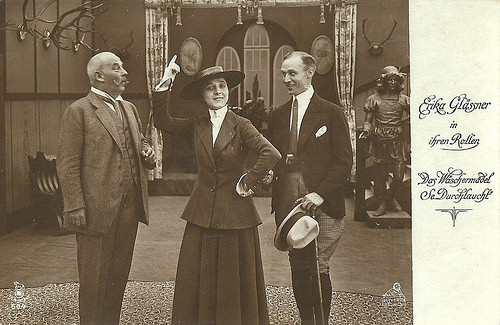
German postcard by Rotophot in the Film Sterne Series, no. 504. Photo: Oliver Film. Publicity still for Das Wäschermädel Seiner Durchlaucht/The Washer Girl of His Highness (Danny Kaden, 1917).

German postcard by Ross Verlag, no. 654/1. Photo: May Film. Erika Glässner and Emil Jannings in Tragödie der Liebe/The Tragedy of Love (Joe May, 1923).

German postcard by Ross Verlag, no. 654/3. Photo: May Film. Erika Glässner in Tragödie der Liebe/The Tragedy of Love (Joe May, 1923).
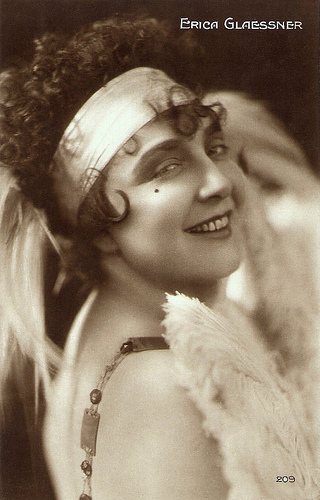
French postcard, no. 209. Photo: publicity still for Tragödie der Liebe/The Tragedy of Love (Joe May, 1923).
Backfische
Marie Johanna Erika Glässner (Glaessner) was born in Erfurt, Germany in 1890. She was the daughter of the painter Gottfried Glässner. Her brother was the opera singer Kurt Glässner. In her youth she received ballet lessons.
In 1910, she debuted as a dancer at the Stadttheater (City Theater) in Erfurt. In the following years she had engagements as a dancer and actress in Olbernhau, Halberstadt and Frankfurt am Main. In 1914 she appeared for the first time on stage in Berlin at the Lustspielhaus (Comedy house). Several successful performances at cabarets and theaters followed.
From 1915 on Erika Glässner played supporting and leading roles in silent films. Her screen debut was in Der moderne Paris oder Der Herr Apotheker heiratet/The modern Paris, or Sir Pharmacist married (Heinrich Bolten-Baeckers, 1915). Her following films were the short Ein nettes Pflänzchen/A Cute Little Fraud (Paul Heidemann, 1916) and Werner Krafft (Carl Froelich, 1916) with Eduard von Winterstein.
In these years she mainly portrayed backfische (teenage girls) in such melodramas as Spiel im Spiel/Play within a play (Emmerich Hanus, 1916) with Friedrich Zelnik , Katinka (Emil Birron, Paul Otto, 1918), and Moral und Sinnlichkeit/Morality and Sensibility (Georg Jacoby, 1919) with Käthe Dorsch .
Opposite Hans Albers she starred in Aus eines Mannes Mädchenjahren/A Man's Girlhood (Karl Grune, Paul Legband, 1919). Reinhold Schünzel cast her next to Liane Haid as a maid in Der Roman eines Dienstmädchens/The Novel of a maid (Reinhold Schünzel, 1921).
During this period, she was often cast as the cheeky temptress, such as in Tragödie der Liebe/Love Tragedy (Joe May, 1923) in which she was the mistress of Emil Jannings . She played the title figure in Die Blumenfrau vom Potsdamer Platz/The flower lady from Potsdamer Platz (Jaap Speyer, 1925). In Kubinke, der Barbier, und die drei Dienstmädchen/Kubinke, the barber, and The three maids (Carl Boese, 1926) her co-star was Werner Fuetterer , and in Gerhard Lamprechts drama Menschen untereinander/Among people (Gerhard Lamprecht, 1926) the star was Alfred Abel.
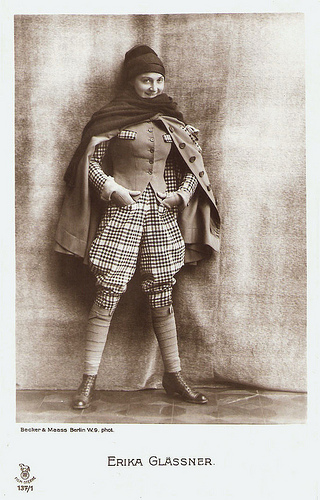
German postcard by Rotophot in the Film Sterne Series, no. 137/1. Photo: Becker & Maass, Berlin.
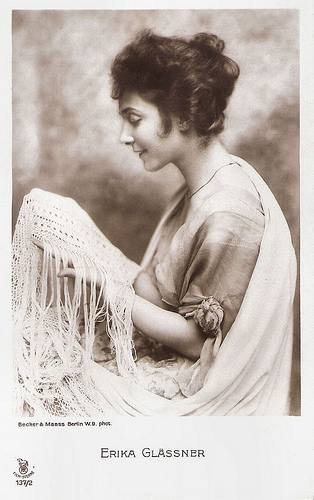
German postcard by Rotophot. in the Film Sterne Series, no. 137/2. Photo: Becker & Maass, Berlin.
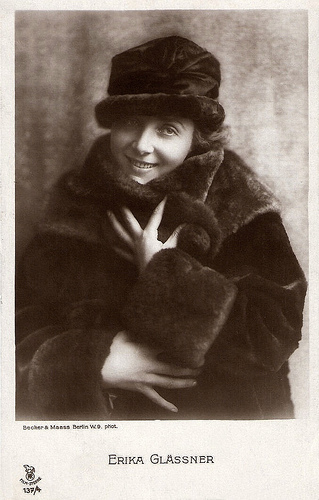
German postcard by Rotophot. in the Film Sterne Series, no. 137/4. Photo: Becker & Maass, Berlin.

German postcard by Rotophot. in the Film-Sterne series, no. 203/2. Photo: Becker & Maass, Berlin.

German postcard by Rotophot. in the Film Sterne series, no. 203/3. Photo: Becker & Maass, Berlin.
Strict aunts and mothers-in-law
In 1926 Erika Glässner married the politician Arnold Kalle. Although her roles became smaller over the years, Glässner remained a busy film actress for a long time. She also continued to play in the theatre.
After the introduction of the sound film, she mainly portrayed such characters as strict aunts and mothers-in-law, or maids or wives. She played in the comedy Madame wünscht keine Kinder/Madame does not want any children (Hans Steinhoff, 1933) with Liane Haid and Georg Alexander , and she appeared with Heinz Rühmann in Heinz im Mond/Heinz in the Moon (Robert A. Stemmle, 1934) as the wife of Oskar Sima , who mimed a stockbroker.
Erich Engel gave her a small role in his adaptation of George Bernard Shaw's Pygmalion (Erich Engel, 1935) with Gustaf Gründgens and Jenny Jugo , and in Der Müde Theodor/The Tired Theodore (Veit Harlan, 1936) she was the wife of the protagonist, played by the Bavarian comedian Weiss-Ferdl.
After the Second World War she had her last film work in two productions of the East-German DEFA studios. In the literary adaptations Corinna Schmidt (Arthur Pohl, 1951) and Karriere in Paris/Career in Paris (Hans-Georg Rudolph, Georg C. Klaren, 1952) she appeared as distinguished ladies from the upper class.
After the death of her husband she retired from the cinema. In 1956 she left the former DDR (East-Germany) and went to live in Giessen, Germany. There Erika Glässner committed suicide in 1959. She was 69. The media did not take notice of the death of the former film star.

German postcard by Photochemie, no. K. 1370. Photo: Alex Binder, Berlin.
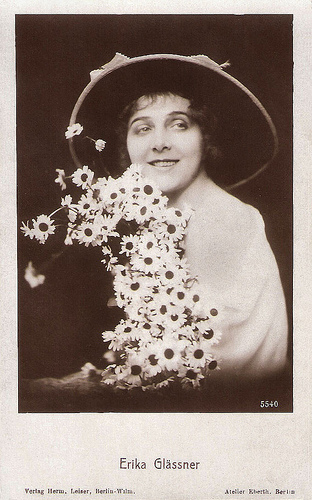
German postcard by Hermann Leiser, Berlin-Wilm, no. 5540. Photo: Atelier Eberth, Berlin.

Yugoslavian postcard. Photo: Bosna Film. Publicity still for the German silent film Tragödie der Liebe/The Tragedy of Love (Joe May, 1923).

German postcard by Verlag Hermann Leiser, Berlin, no. 3269. Photo: Zander & Lubisch. Publicity still for Menschen untereinander/People to Each Other (Gerhard Lamprecht, 1926).

German postcard by Ross Verlag, no. 771/2, 1925-1926. Photo: Alex Binder.

German postcard by Ross Verlag, no. 772/2, 1925-1926. Photo: Alex Binder.

German postcard by Ross Verlag, no. 1022/2, 1927-1928. Photo: Alex Binder.
Sources: Stephanie D’heil (Steffi-line - German), Thomas Staedeli (Cyranos), DEFA Filmsterne (German), Filmportal.de, Film-Zeit.de (German), Wikipedia (German) and .

German postcard by Verlag Hermann Leiser, Berlin, no. 2320. Photo: B.J.G.

German postcard by Rotophot in the Film Sterne Series, no. 504. Photo: Oliver Film. Publicity still for Das Wäschermädel Seiner Durchlaucht/The Washer Girl of His Highness (Danny Kaden, 1917).

German postcard by Ross Verlag, no. 654/1. Photo: May Film. Erika Glässner and Emil Jannings in Tragödie der Liebe/The Tragedy of Love (Joe May, 1923).

German postcard by Ross Verlag, no. 654/3. Photo: May Film. Erika Glässner in Tragödie der Liebe/The Tragedy of Love (Joe May, 1923).

French postcard, no. 209. Photo: publicity still for Tragödie der Liebe/The Tragedy of Love (Joe May, 1923).
Backfische
Marie Johanna Erika Glässner (Glaessner) was born in Erfurt, Germany in 1890. She was the daughter of the painter Gottfried Glässner. Her brother was the opera singer Kurt Glässner. In her youth she received ballet lessons.
In 1910, she debuted as a dancer at the Stadttheater (City Theater) in Erfurt. In the following years she had engagements as a dancer and actress in Olbernhau, Halberstadt and Frankfurt am Main. In 1914 she appeared for the first time on stage in Berlin at the Lustspielhaus (Comedy house). Several successful performances at cabarets and theaters followed.
From 1915 on Erika Glässner played supporting and leading roles in silent films. Her screen debut was in Der moderne Paris oder Der Herr Apotheker heiratet/The modern Paris, or Sir Pharmacist married (Heinrich Bolten-Baeckers, 1915). Her following films were the short Ein nettes Pflänzchen/A Cute Little Fraud (Paul Heidemann, 1916) and Werner Krafft (Carl Froelich, 1916) with Eduard von Winterstein.
In these years she mainly portrayed backfische (teenage girls) in such melodramas as Spiel im Spiel/Play within a play (Emmerich Hanus, 1916) with Friedrich Zelnik , Katinka (Emil Birron, Paul Otto, 1918), and Moral und Sinnlichkeit/Morality and Sensibility (Georg Jacoby, 1919) with Käthe Dorsch .
Opposite Hans Albers she starred in Aus eines Mannes Mädchenjahren/A Man's Girlhood (Karl Grune, Paul Legband, 1919). Reinhold Schünzel cast her next to Liane Haid as a maid in Der Roman eines Dienstmädchens/The Novel of a maid (Reinhold Schünzel, 1921).
During this period, she was often cast as the cheeky temptress, such as in Tragödie der Liebe/Love Tragedy (Joe May, 1923) in which she was the mistress of Emil Jannings . She played the title figure in Die Blumenfrau vom Potsdamer Platz/The flower lady from Potsdamer Platz (Jaap Speyer, 1925). In Kubinke, der Barbier, und die drei Dienstmädchen/Kubinke, the barber, and The three maids (Carl Boese, 1926) her co-star was Werner Fuetterer , and in Gerhard Lamprechts drama Menschen untereinander/Among people (Gerhard Lamprecht, 1926) the star was Alfred Abel.

German postcard by Rotophot in the Film Sterne Series, no. 137/1. Photo: Becker & Maass, Berlin.

German postcard by Rotophot. in the Film Sterne Series, no. 137/2. Photo: Becker & Maass, Berlin.

German postcard by Rotophot. in the Film Sterne Series, no. 137/4. Photo: Becker & Maass, Berlin.

German postcard by Rotophot. in the Film-Sterne series, no. 203/2. Photo: Becker & Maass, Berlin.

German postcard by Rotophot. in the Film Sterne series, no. 203/3. Photo: Becker & Maass, Berlin.
Strict aunts and mothers-in-law
In 1926 Erika Glässner married the politician Arnold Kalle. Although her roles became smaller over the years, Glässner remained a busy film actress for a long time. She also continued to play in the theatre.
After the introduction of the sound film, she mainly portrayed such characters as strict aunts and mothers-in-law, or maids or wives. She played in the comedy Madame wünscht keine Kinder/Madame does not want any children (Hans Steinhoff, 1933) with Liane Haid and Georg Alexander , and she appeared with Heinz Rühmann in Heinz im Mond/Heinz in the Moon (Robert A. Stemmle, 1934) as the wife of Oskar Sima , who mimed a stockbroker.
Erich Engel gave her a small role in his adaptation of George Bernard Shaw's Pygmalion (Erich Engel, 1935) with Gustaf Gründgens and Jenny Jugo , and in Der Müde Theodor/The Tired Theodore (Veit Harlan, 1936) she was the wife of the protagonist, played by the Bavarian comedian Weiss-Ferdl.
After the Second World War she had her last film work in two productions of the East-German DEFA studios. In the literary adaptations Corinna Schmidt (Arthur Pohl, 1951) and Karriere in Paris/Career in Paris (Hans-Georg Rudolph, Georg C. Klaren, 1952) she appeared as distinguished ladies from the upper class.
After the death of her husband she retired from the cinema. In 1956 she left the former DDR (East-Germany) and went to live in Giessen, Germany. There Erika Glässner committed suicide in 1959. She was 69. The media did not take notice of the death of the former film star.

German postcard by Photochemie, no. K. 1370. Photo: Alex Binder, Berlin.

German postcard by Hermann Leiser, Berlin-Wilm, no. 5540. Photo: Atelier Eberth, Berlin.

Yugoslavian postcard. Photo: Bosna Film. Publicity still for the German silent film Tragödie der Liebe/The Tragedy of Love (Joe May, 1923).

German postcard by Verlag Hermann Leiser, Berlin, no. 3269. Photo: Zander & Lubisch. Publicity still for Menschen untereinander/People to Each Other (Gerhard Lamprecht, 1926).

German postcard by Ross Verlag, no. 771/2, 1925-1926. Photo: Alex Binder.

German postcard by Ross Verlag, no. 772/2, 1925-1926. Photo: Alex Binder.

German postcard by Ross Verlag, no. 1022/2, 1927-1928. Photo: Alex Binder.
Sources: Stephanie D’heil (Steffi-line - German), Thomas Staedeli (Cyranos), DEFA Filmsterne (German), Filmportal.de, Film-Zeit.de (German), Wikipedia (German) and .
Published on November 16, 2016 22:00
November 15, 2016
Cirano di Bergerac (1923)
The Franco-Italian historical film Cirano di Bergerac (Augusto Genina, 1923) was based on Edmond Rostand's often-filmed play Cyrano de Bergerac. Pierre Magnier starred as Cyrano de Bergerac, the gentleman with the unusually long nose, Linda Moglia played his beautiful but unreachable niece Roxane and Angelo Ferrari played his friend and rival in love Christian de Neuvillette. Will Cyrano ever find love?
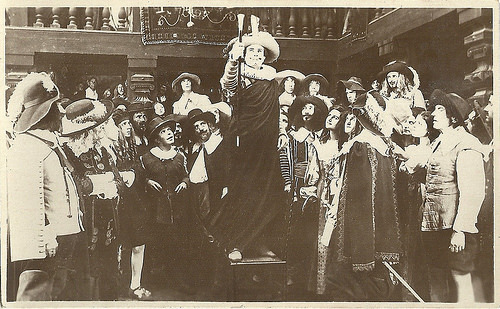
Italian postcard. Photo: UCI. Publicity still for Cirano di Bergerac (Augusto Genina, 1923) with Pierre Magnier as Cyrano de Bergerac. Caption: The witty remarks by Cyrano cause for hilarity among the populace present at the theatre.
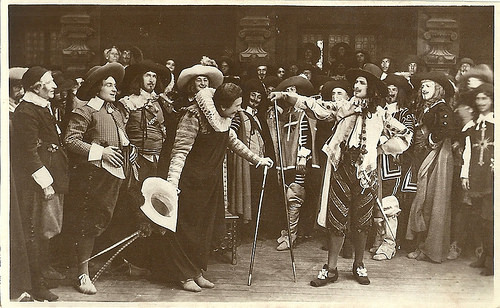
Italian postcard. Photo: UCI. Publicity still for Cirano di Bergerac (Augusto Genina, 1923) with Pierre Magnier as Cyrano de Bergerac. Caption: Jokingly Cyrano ironizes the presumptuous Gascogne noble, before duelling with him.
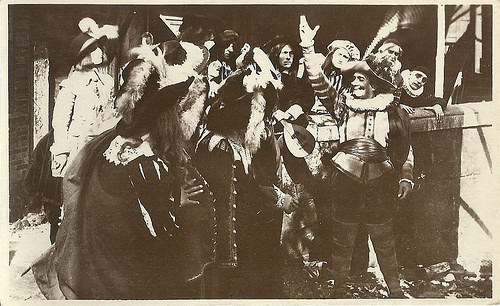
Italian postcard. Photo: UCI. Publicity still for Cirano di Bergerac (Augusto Genina, 1923) with Pierre Magnier as Cyrano de Bergerac. Caption: A tale by Cyrano.
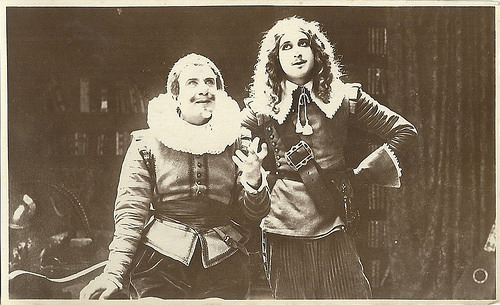
Italian postcard. Photo: UCI. Publicity still for Cirano di Bergerac (Augusto Genina, 1923) with Pierre Magnier as Cyrano de Bergerac and Angelo Ferrari as Christian de Neuvillette. Caption: Cyrano addresses to Roxane his most ardent words of love by the lips of Christian, who, incapable to invent such words, memorises them thanks to Cyrano.
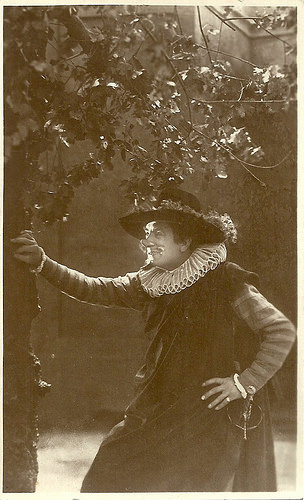
Italian postcard. Photo: UCI. Publicity still for Cirano di Bergerac (Augusto Genina, 1923) with Pierre Magnier as Cyrano de Bergerac. Caption: Hidden between the foliage in the garden, Cyrano suggests Christian the magic, sublime words that the latter isn't capable to invent and that aside Roxane's delicate inhibitions.
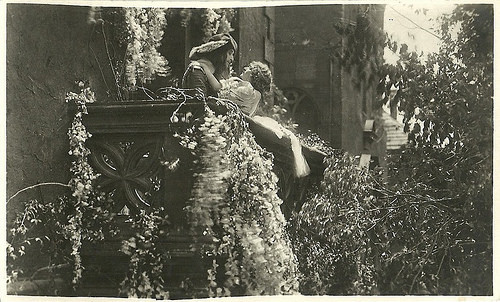
Italian postcard. Photo: UCI. Publicity still for Cirano di Bergerac (Augusto Genina, 1923) with Linda Moglia as Roxane and Angelo Ferrari as Christian de Neuvillette. Caption: Christian joins the baluster, finally embracing Roxane. He bends towards her mouth to receive the kiss from her, who has bent because of the sweet words Cyrano lent him.
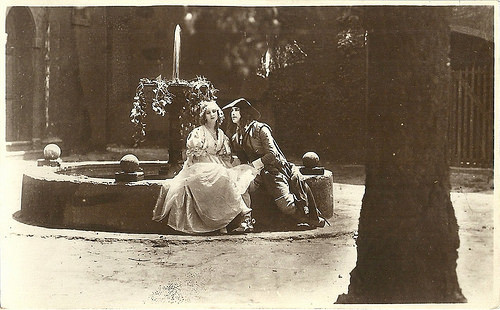
Italian postcard. Photo: UCI. Publicity still for Cirano di Bergerac (Augusto Genina, 1923) with Linda Moglia as Roxane and Angelo Ferrari as Christian de Neuvillette. Caption: the nice phrases of Christian he learned from Cyrano have conquered and seduced Roxane.
A brave and eloquent gentleman doted with an unusually long nose
Cirano di Bergerac (Augusto Genina, 1923) traces the classical story by Edmond Rostand about the strong, witty and eloquent gentleman, a poet, a leader and filled with plenty of charisma and bravado in 17th Century France. He has only one flaw: an unusually long nose. Although there was a real Cyrano de Bergerac, the play is a fictionalisation of his life that follows the broad outlines of it.
Future film director Mario Camerini wrote the script for the silent film version. Cirano di Bergerac was shot in 1922. French stage and screen actor Pierre Magnier played Cyrano. Magnier would act in over 100 films and was also known for La roue (Abel Gance, 1923), and La règle du jeu (Jean Renoir, 1939).
Whoever challenges Cyrano for his nose, will meet his sword. As Cyrano cannot have his beautiful niece Roxane (Linda Moglia) because of his looks, he secretly helps young Christian de Neuvillette (Angelo Ferrari) to seduce her using Cyrano's poetic words.
Christian and Roxane secretly marry before he goes to war, together with Cyrano. From the camp Cyrano writes Roxane poetic letters in Christian's name which increase her love for the young man, so much that she visits the camp and declares Christian she even would love him if he were not beautiful anymore, hurting Christian's feelings.
Just as Cyrano is about to confess Roxane his fraud, Christian is shot and he dies in Roxane's arms, content that Roxane really loves him.
Five years after, like always Cyrano visits Roxane in the convent where she has retired. This day his old enemies have mortally wounded him but he covers the wound with his hat. When Cyrano is once more reciting Christian's last letter and can do so from the head, Roxane discovers Cyrano was the true author of all of Christian's poetry and understands. It is too late. Cyrano dies reciting his lines.
In 1923, the film won an award at the Turin festival. Afterwards the whole film was stencil-coloured in Pathé-color, a version released only in 1925. It was this version that in 1999 was fully restored by Film Preservation Associates for ARTE, in collaboration with avid Shepard, and with post-production by Lobster. Kurt Kuenne composed new music, executed by the Olympia Chamber Orchestra led by Timothy Brock. Afterwards a DVD of Cirano di Bergerac was released by Absolute Medien, together with ARTE.
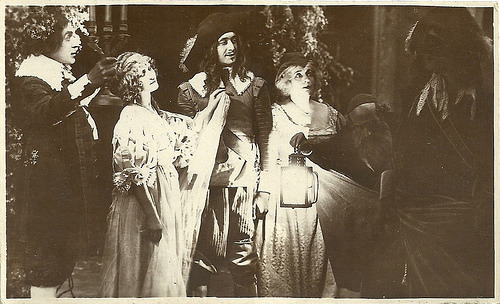
Italian postcard. Photo: UCI. Publicity still for Cirano di Bergerac (Augusto Genina, 1923) with Linda Moglia as Roxane and Angelo Ferrari as Christian de Neuvillette. Caption: Roxane and Christian de Neuvillette marry.
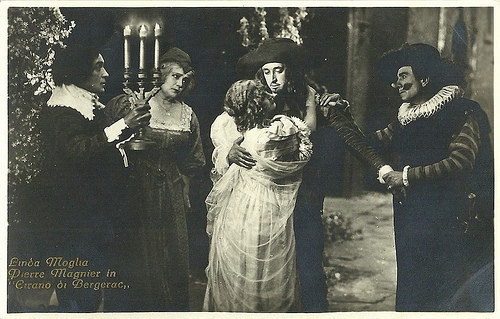
Italian postcard. Photo: UCI. Publicity still for Cirano di Bergerac (Augusto Genina, 1923) with Linda Moglia as Roxane and Pierre Magnier as Cyrano de Bergerac.
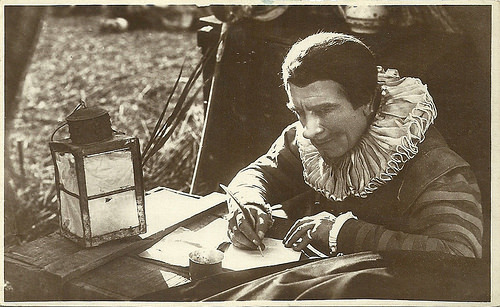
Italian postcard. Photo: UCI. Publicity still for Cirano di Bergerac (Augusto Genina, 1923) with Pierre Magnier as Cyrano de Bergerac. Caption: During the siege of Arras, Cyrano writes to Roxane on behalf of Christian the most ardent words an enamoured heart could have suggested.
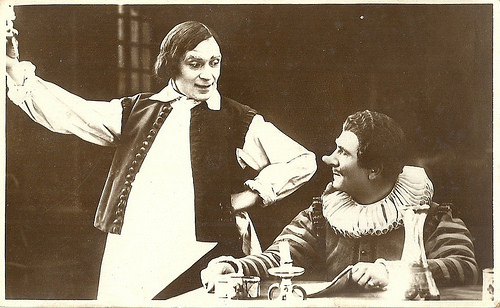
Italian postcard. Photo: UCI. Publicity still for Cirano di Bergerac (Augusto Genina, 1923) with Pierre Magnier as Cyrano de Bergerac. Caption: Cyrano writes...
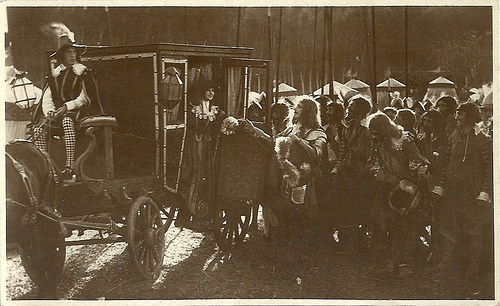
Italian postcard. Photo: UCI. Publicity still for Cirano di Bergerac (Augusto Genina, 1923) with Linda Moglia as Roxane and Angelo Ferrari as Christian de Neuvillette. Caption: Defying danger, Roxane joins Christian at Arras, where he is camping with the soldiers.
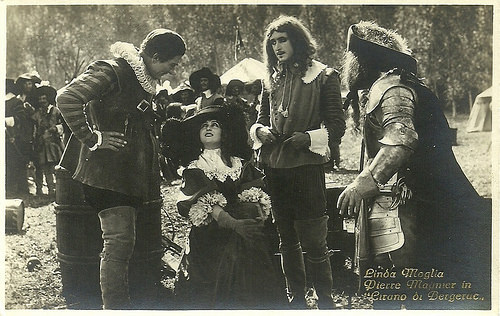
Italian postcard. Photo: UCI. Publicity still for Cirano di Bergerac (Augusto Genina, 1923) with Linda Moglia as Roxane and Pierre Magnier as Cyrano de Bergerac.
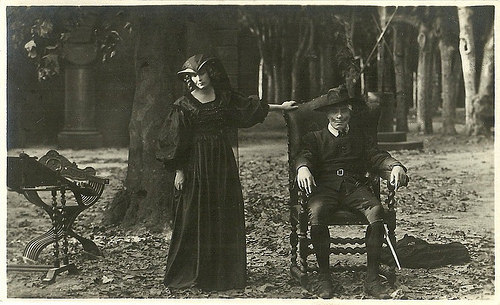
Italian postcard. Photo: UCI. Publicity still for Cirano di Bergerac (Augusto Genina, 1923) with Linda Moglia as Roxane and Pierre Magnier as Cyrano de Bergerac. Caption: A few cronies of the Duke de Guiche have treacherously hit Cyrano. He still has the force to go to his beloved Roxane, and involuntarily he reveals his heroic sacrifice.
Sources: Wikipedia and IMDb.

Italian postcard. Photo: UCI. Publicity still for Cirano di Bergerac (Augusto Genina, 1923) with Pierre Magnier as Cyrano de Bergerac. Caption: The witty remarks by Cyrano cause for hilarity among the populace present at the theatre.

Italian postcard. Photo: UCI. Publicity still for Cirano di Bergerac (Augusto Genina, 1923) with Pierre Magnier as Cyrano de Bergerac. Caption: Jokingly Cyrano ironizes the presumptuous Gascogne noble, before duelling with him.

Italian postcard. Photo: UCI. Publicity still for Cirano di Bergerac (Augusto Genina, 1923) with Pierre Magnier as Cyrano de Bergerac. Caption: A tale by Cyrano.

Italian postcard. Photo: UCI. Publicity still for Cirano di Bergerac (Augusto Genina, 1923) with Pierre Magnier as Cyrano de Bergerac and Angelo Ferrari as Christian de Neuvillette. Caption: Cyrano addresses to Roxane his most ardent words of love by the lips of Christian, who, incapable to invent such words, memorises them thanks to Cyrano.

Italian postcard. Photo: UCI. Publicity still for Cirano di Bergerac (Augusto Genina, 1923) with Pierre Magnier as Cyrano de Bergerac. Caption: Hidden between the foliage in the garden, Cyrano suggests Christian the magic, sublime words that the latter isn't capable to invent and that aside Roxane's delicate inhibitions.

Italian postcard. Photo: UCI. Publicity still for Cirano di Bergerac (Augusto Genina, 1923) with Linda Moglia as Roxane and Angelo Ferrari as Christian de Neuvillette. Caption: Christian joins the baluster, finally embracing Roxane. He bends towards her mouth to receive the kiss from her, who has bent because of the sweet words Cyrano lent him.

Italian postcard. Photo: UCI. Publicity still for Cirano di Bergerac (Augusto Genina, 1923) with Linda Moglia as Roxane and Angelo Ferrari as Christian de Neuvillette. Caption: the nice phrases of Christian he learned from Cyrano have conquered and seduced Roxane.
A brave and eloquent gentleman doted with an unusually long nose
Cirano di Bergerac (Augusto Genina, 1923) traces the classical story by Edmond Rostand about the strong, witty and eloquent gentleman, a poet, a leader and filled with plenty of charisma and bravado in 17th Century France. He has only one flaw: an unusually long nose. Although there was a real Cyrano de Bergerac, the play is a fictionalisation of his life that follows the broad outlines of it.
Future film director Mario Camerini wrote the script for the silent film version. Cirano di Bergerac was shot in 1922. French stage and screen actor Pierre Magnier played Cyrano. Magnier would act in over 100 films and was also known for La roue (Abel Gance, 1923), and La règle du jeu (Jean Renoir, 1939).
Whoever challenges Cyrano for his nose, will meet his sword. As Cyrano cannot have his beautiful niece Roxane (Linda Moglia) because of his looks, he secretly helps young Christian de Neuvillette (Angelo Ferrari) to seduce her using Cyrano's poetic words.
Christian and Roxane secretly marry before he goes to war, together with Cyrano. From the camp Cyrano writes Roxane poetic letters in Christian's name which increase her love for the young man, so much that she visits the camp and declares Christian she even would love him if he were not beautiful anymore, hurting Christian's feelings.
Just as Cyrano is about to confess Roxane his fraud, Christian is shot and he dies in Roxane's arms, content that Roxane really loves him.
Five years after, like always Cyrano visits Roxane in the convent where she has retired. This day his old enemies have mortally wounded him but he covers the wound with his hat. When Cyrano is once more reciting Christian's last letter and can do so from the head, Roxane discovers Cyrano was the true author of all of Christian's poetry and understands. It is too late. Cyrano dies reciting his lines.
In 1923, the film won an award at the Turin festival. Afterwards the whole film was stencil-coloured in Pathé-color, a version released only in 1925. It was this version that in 1999 was fully restored by Film Preservation Associates for ARTE, in collaboration with avid Shepard, and with post-production by Lobster. Kurt Kuenne composed new music, executed by the Olympia Chamber Orchestra led by Timothy Brock. Afterwards a DVD of Cirano di Bergerac was released by Absolute Medien, together with ARTE.

Italian postcard. Photo: UCI. Publicity still for Cirano di Bergerac (Augusto Genina, 1923) with Linda Moglia as Roxane and Angelo Ferrari as Christian de Neuvillette. Caption: Roxane and Christian de Neuvillette marry.

Italian postcard. Photo: UCI. Publicity still for Cirano di Bergerac (Augusto Genina, 1923) with Linda Moglia as Roxane and Pierre Magnier as Cyrano de Bergerac.

Italian postcard. Photo: UCI. Publicity still for Cirano di Bergerac (Augusto Genina, 1923) with Pierre Magnier as Cyrano de Bergerac. Caption: During the siege of Arras, Cyrano writes to Roxane on behalf of Christian the most ardent words an enamoured heart could have suggested.

Italian postcard. Photo: UCI. Publicity still for Cirano di Bergerac (Augusto Genina, 1923) with Pierre Magnier as Cyrano de Bergerac. Caption: Cyrano writes...

Italian postcard. Photo: UCI. Publicity still for Cirano di Bergerac (Augusto Genina, 1923) with Linda Moglia as Roxane and Angelo Ferrari as Christian de Neuvillette. Caption: Defying danger, Roxane joins Christian at Arras, where he is camping with the soldiers.

Italian postcard. Photo: UCI. Publicity still for Cirano di Bergerac (Augusto Genina, 1923) with Linda Moglia as Roxane and Pierre Magnier as Cyrano de Bergerac.

Italian postcard. Photo: UCI. Publicity still for Cirano di Bergerac (Augusto Genina, 1923) with Linda Moglia as Roxane and Pierre Magnier as Cyrano de Bergerac. Caption: A few cronies of the Duke de Guiche have treacherously hit Cyrano. He still has the force to go to his beloved Roxane, and involuntarily he reveals his heroic sacrifice.
Sources: Wikipedia and IMDb.
Published on November 15, 2016 22:00
November 14, 2016
Quo vadis? (1924-1925)
Last Sunday, an exhibition on the transmediality of Quo vadis? opened in Rome, Italy, and yesterday also a conference started on Quo vadis?. EFSP collaborator Ivo Blom speaks in Rome about the painters Gérôme and Alma-Tadema and the film maker Guazzoni, director of the second film adaptation of Quo vadis, the subject of our post yesterday. Today, EFSP presents a film special about the third film adaptation of Henryk Sienkiewicz's famous novel, the German-Italian co-production Quo vadis? (Georg Jacoby, Gabriellino D'Annunzio, 1924-1925). Emil Jannings, famous star of the German silent cinema, was cast as the evil emperor Nero.

German postcard by Ross Verlag, no. 699/1, 1919-1924. Photo: Filmhaus Bruckmann. Publicity still for Quo vadis? (Georg Jacoby, Gabriellino D'Annunzio, 1924-1925). Here we see Nero ( Emil Jannings ) going out of his mind when his little son dies.
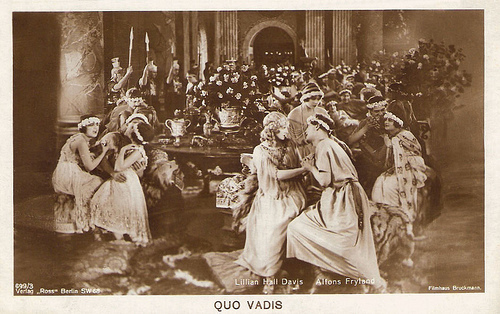
German postcard by Ross Verlag, no. 699/3, 1919-1924. Photo: Filmhaus Bruckmann. Publicity still for Quo vadis? (Georg Jacoby, Gabriellino D'Annunzio, 1924-1925). Here, Marcus Vinicius ( Alphons Fryland ) tries to seduce the chaste Lygia ( Lilian Hall-Davis ) during an orgy at Nero's palace.
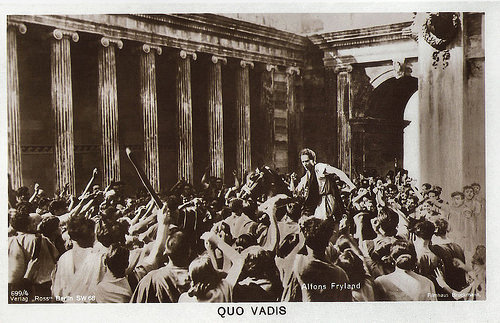
German postcard by Ross Verlag, no. 699/4, 1919-1924. Photo: Filmhaus Bruckmann. Publicity still for Quo vadis? (Gabriellino D'Annunzio, Georg Jacoby, 1925). Marcus Vinicius ( Alphons Fryland ) leads the populace against Nero.

German postcard by Ross Verlag, no. 699/5, 1919-1924. Photo: Filmhaus Bruckmann. Publicity still for Quo vadis? (Georg Jacoby, Gabriellino D'Annunzio, 1924-1925). Here we see Ursus ( Bruto Castellani ) liberating Lygia ( Lilian Hall-Davis ) after he has conquered the raging bull. Castellani's face and hair are clearly drawn afterwards. In the film the nudity is only visible for a fraction of a second.
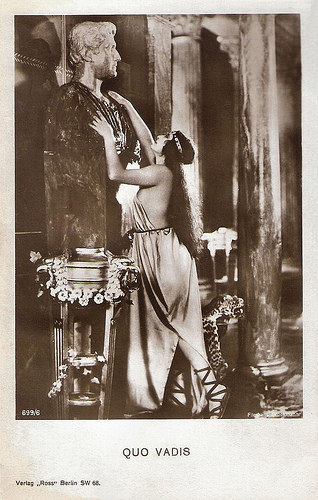
German postcard by Ross Verlag, Berlin, no. 699/6, 1919-1924. Photo: Filmhaus Brückmann. Publicity still for Quo vadis? (Gabriellino D'Annunzio, Georg Jacoby, 1924) with Rina De Liguoro as Eunice, secretly in love with her master Petronius ( André Habay ).
A huge spectacle
Ten years after the smashing success of director Enrico Guazzoni's colossal epic Quo vadis? (1913), the Unione Cinematografica Italiana (U.C.I.) decided to make a new silent film version.
The Unione Cinematografica Italiana was an Ufa-like or Universal-like merger of many Italian pre-war film companies. Grand old man Arturo Ambrosio was the producer of the third film version, Quo vadis? (1924-1925), and personally involved in the project from 1923.
Directors were the German Georg Jacoby and the Italian Gabriellino D' Annunzio, son of Gabriele D'Annunzio, the famous Italian writer and adventurer.
They turned Sienkiewicz's story of Emperor Nero's politically motivated persecution of the early Christians to hush up his own burning of Rome, and of the 'conversion' of an agnostic Roman warrior via the love of a virtuous Christian girl, into a huge spectacle.
Highlights are the 'burning of Rome' scenes and the climactic fights and carnage in the gladiatorial arena. Cinematography was by Giovanni Vitrotti, Alfredo Donelli, and Curt Courant.
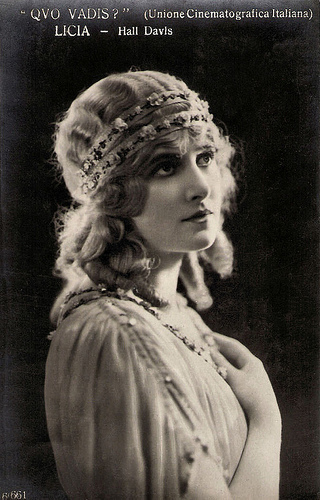
Italian postcard by Ed. A. Traldi, Milano, no. 651. Photo: Lilian Hall-Davis as Licia/Lygia in Quo vadis? (Gabriellino D'Annunzio, Georg Jacoby, 1924-1925).
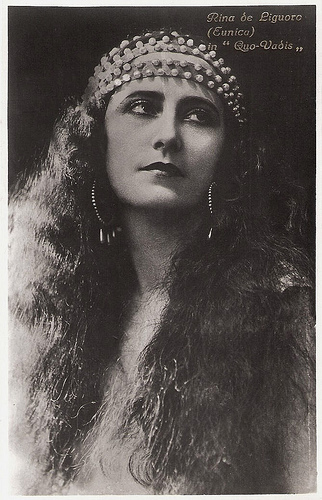
Italian postcard by Ed. G.B. Falci, Milano. Photo: Rina De Liguoro as Eunice in Quo vadis? (Gabriellino D' Annunzio, Georg Jacoby, 1924-1925).
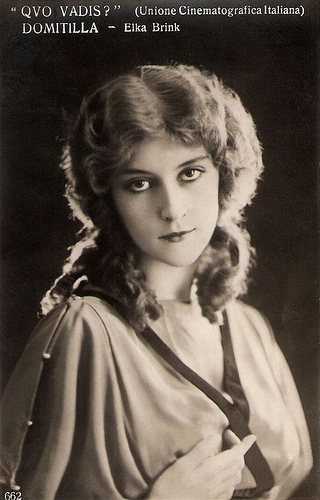
Italian postcard by Ed. A. Traldi, Milano, no. 662. Photo: Elga Brink as Domitilla in Quo vadis? (Gabriellino D'Annunzio, Georg Jacoby, 1924-1925).
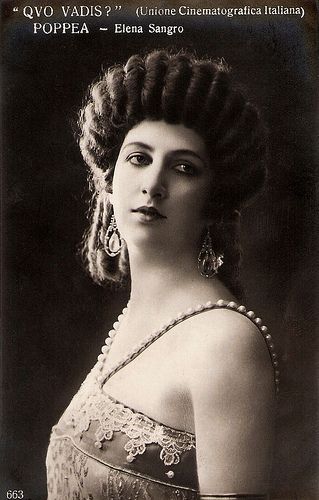
Italian postcard by Ed. A. Traldi, Milano, no. 663. Photo: Elena Sangro as the Empress Poppaea in Quo vadis? (Gabriellino D'Annunzio, Georg Jacoby, 1924-1925).
A Stellar Cast
The historical epic was shot in Rome with a stellar cast of international silent stars. One of the brightest stars of the British silent cinema, Lilian Hall-Davis , and Austrian actor Alphons Fryland played the two young lovers Lygia (Licia in Italian) and Marcus Vinicius.
The German actress Elga Brink appeared as Domitilla. She has a spectacular scene, when as Christian martyr she is first dragged by a chariot through the circus, but then manages to climb up the chariot, take the reins and finish the race, to the great joy of the audience. Italian actor André Habay portrayed Marcus' uncle Petronius, Nero's 'arbiter elegantiae', who uses his wit to flatter and mock him at the same time. Italian diva Rina De Liguoro played Petronius' slave Eunice who later on becomes his mistress and dies with him.
And then there was the famous star of the German silent cinema, Emil Jannings , who was cast as the emperor Nero. Hal Erickson at AllMovie : "Jannings tackles the role of Nero with lusty abandon, making this already larger-than-life historical personality even more so." While in the 1913 version Carlo Cattaneo gave a more naive version of Nero, more the victim of his surroundings, Jannings' Nero is clearly a perverse and sadistic man, who enjoys other people's misery, frightens and plays with his courtiers, and hypocritically offers Licia's his help after Vinicius has been too rough to her, only to reveal later on his own real, lustful intentions. It is also clear the filmmakers gave Jannings a much bigger part in the film than his predecessor or than in the novel. The publicity highlighted his presence as star of the film too.
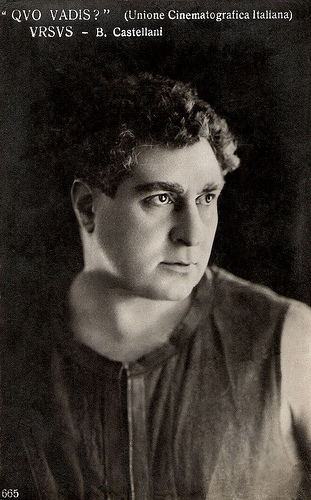
Italian Postcard by Ed. A. Traldi, Milano, no. 665. Photo: Bruto Castellani as Ursus in Quo vadis? (Gabriellino D' Annunzio, Georg Jacoby, 1924-1925).
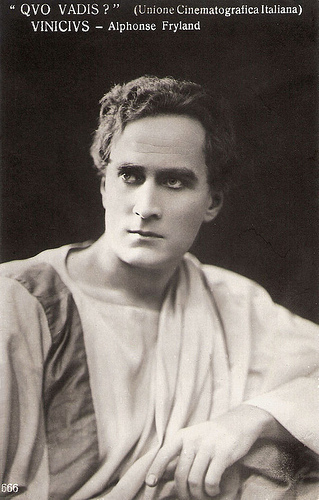
Italian postcard by Ed. Romeo Biagi, Bologna, no. 666. Photo: Unione Cinematografica Italiana. Alphons Fryland as Vinicius in Quo vadis? (Gabriellino D' Annunzio, Georg Jacoby, 1924-1925).
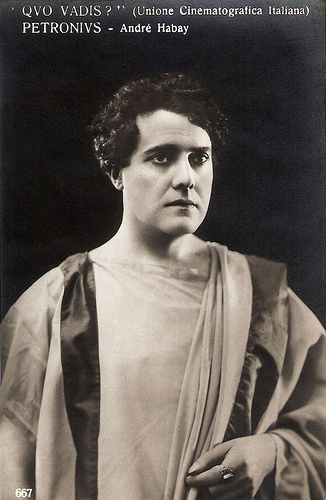
Italian postcard by Ed. A. Traldi, Milano, no. 667. Photo: André Habay as Petronius in Quo vadis? (Gabriellino D'Annunzio, Georg Jacoby, 1924-1925).
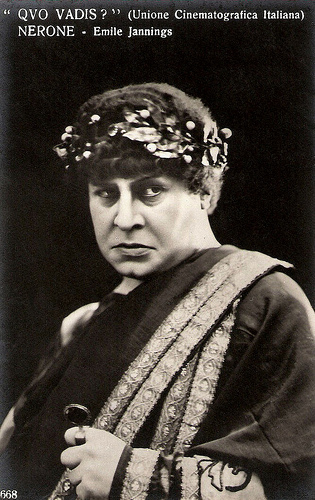
Italian postcard by Ed. A. Traldi, Milano, no. 668. Photo: Unione Cinematografica Italiano. Publicity still of Emil Jannings as Nero in Quo vadis? (Georg Jacoby, Gabriellino D'Annunzio, 1924-1925).
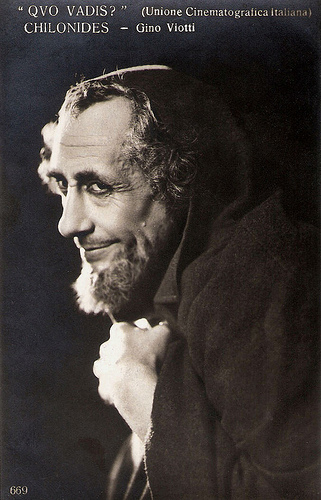
Italian postcard by Ed. A. Traldi, Milano, no. 669. Photo: Gino Viotti as the lecherous and treacherous Greek Chilo Chilonides in Quo vadis? (Gabriellino D'Annunzio, Georg Jacoby, 1924-1925).
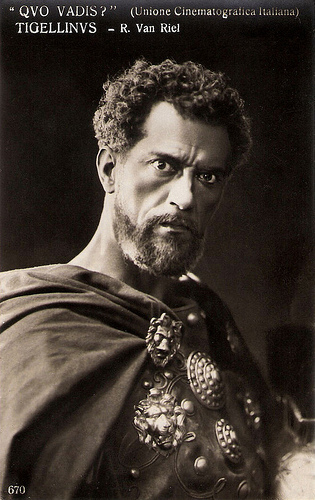
Italian postcard by Ed. A. Traldi, Milano, no. 670. Photo: Raimondo Van Riel as Nero's evil general Tigellinus in Quo vadis? (Gabriellino D'Annunzio, Georg Jacoby, 1924-1925).
Streaks of Sadism and Nudity
Quo vadis? had its Roman premiere on 16 March 1925. The producer had tried to equal the earlier version of 1913, adding enormous sets, designed by sculptor and architect Armando Brasini, and streaks of sadism & nudity, some already present in the novel (e.g. the human torches), others added to attract audiences (e.g. a female fed to Nero's lampreys).
The 1925 version didn't have the worldwide success of Enrico Guazzoni's earlier film. For various reasons: people were a bit bored with epic films and the censor had ordered cuts, such as the too explicit scenes of orgy, violence and blood gulping. The producer almost went bankrupt over copyright claims he all had to pay.
It didn't help that the lion tamer Alfred Schneider was convicted because one of his circus lions had bitten and killed an extra.
Still a fascinating film, especially for the performances of Emil Jannings as the evil emperor Nero, Elena Sangro as the empress Poppaea and Bruto Castellani as the strong man Ursus. Castellani had performed the role before in the 1913 version of Quo vadis?
Hal Erickson at AllMovie: "Although not as much of a cinematic landmark as the 1913 version of Quo Vadis?, this 1924 Italian adaptation of the Henryk Sienkiewicz best-seller was a splendidly lavish production, not to mention a worldwide box-office success."
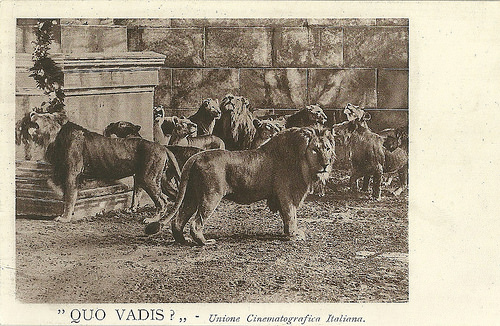
Italian postcard by Edizione L'Argentografica, Torino. Photo: UCI (Unione Cinematografica Italiana). Publicity still for Quo vadis? (Gabriellino D'Annunzio, Georg Jacoby, 1924).

Italian postcard by Edizione L'Argentografica, Torino. Photo: UCI (Unione Cinematografica Italiana). Publicity still for Quo vadis? (Gabriellino D'Annunzio, Georg Jacoby, 1924), starring Emil Jannings as Nero, and Elena Sangro as Poppaea. When Chilo exposes Nero as arsonist, the emperor shoots him.

Italian postcard by Edizione L'Argentografica, Torino. Photo: UCI (Unione Cinematografica Italiana). Publicity still for Quo vadis? (Gabriellino D'Annunzio, Georg Jacoby, 1924). Petronius (André Habay) greets Nero (Emil Jannings).
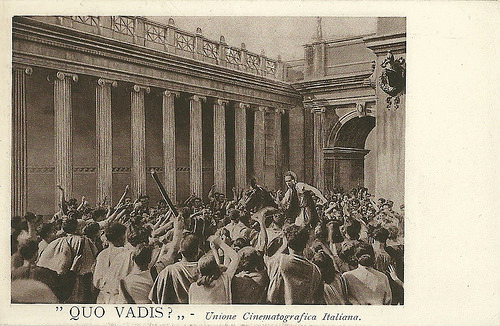
Italian postcard by Edizione L'Argentografica, Torino. Photo: UCI (Unione Cinematografica Italiana). Publicity still for Quo vadis? (Gabriellino D'Annunzio, Georg Jacoby, 1924), with Alphons Fryland as Vinicius.
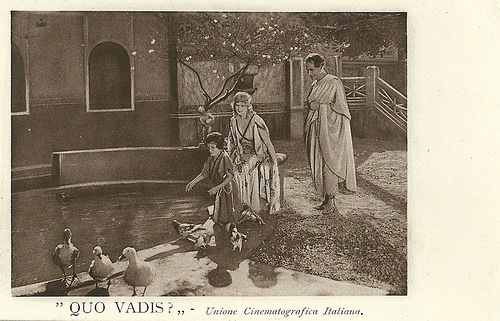
Italian postcard by Edizione L'Argentografica, Torino. Photo: UCI (Unione Cinematografica Italiana). Publicity still for Quo vadis? (Gabriellino D'Annunzio, Georg Jacoby, 1924), with Marcella Sabatini, Lilian Hall-Davis as Lygia and Alphons Fryland as Vinicius.
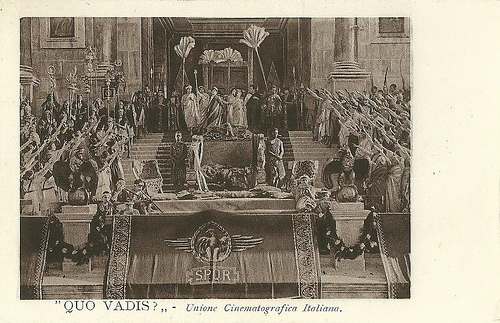
Italian postcard by Edizione L'Argentografica, Torino. Photo: UCI (Unione Cinematografica Italiana). Publicity still for Quo vadis? (Gabriellino D'Annunzio, Georg Jacoby, 1924). The large architectural constructions of Nero's palace on the Palatine were by Armando Brasini, while R. Ferro and G. Spellani took care of the general production design.
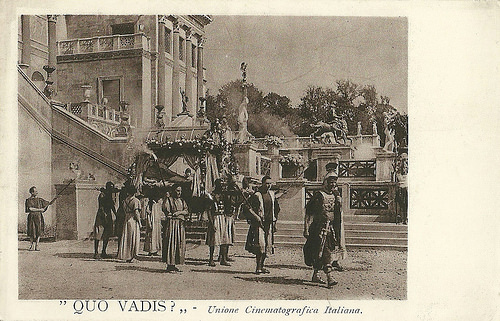
Italian postcard by Edizione L'Argentografica, Torino. Photo: UCI (Unione Cinematografica Italiana). Publicity still for Quo vadis? (Gabriellino D'Annunzio, Georg Jacoby, 1924).

Italian postcard by Edizione L'Argentografica, Torino. Photo: UCI (Unione Cinematografica Italiana). Publicity still for Quo vadis? (Gabriellino D'Annunzio, Georg Jacoby, 1924). The soothsayer, explaining Nero's nightmare.
Magnificently Restored
Hal Erickson mentions at AllMovie that the subsequent Hollywood popularity of Emil Jannings prompted a reissue of Quo vadis? in 1929. Reportedly a newly recorded musical score was added.
In 1951 Hollywood made a new version with sound and in colour, Quo Vadis (Mervyn LeRoy, 1951). The film stars Robert Taylor, Deborah Kerr , Leo Genn , and Peter Ustinov. It was nominated for eight Academy Awards.
Fifty years later followed a Polish adaptation by Jerzy Kawalerowicz: Quo Vadis (2001). There was also a 1985 mini-series starring Klaus Maria Brandauer as Nero.
Also in 2001, the Dutch Filmmuseum (now Eye Institute) in Amsterdam restored the silent 1924 version of Quo vadis?, based on various existing copies. This magnificently restored version had its 're-premiere' at the Bologna film festival Cinema Ritrovato in 2002.
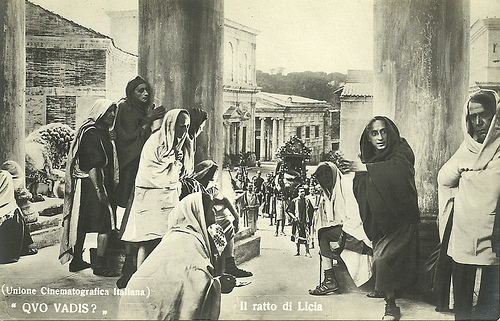
Italian postcard. Photo: UCI (Unione Cinematografica Italiana). Publicity still of the scene of the kidnapping of Lygia in Quo vadis? (Gabriellino D'Annunzio, Georg Jacoby, 1924-1925).
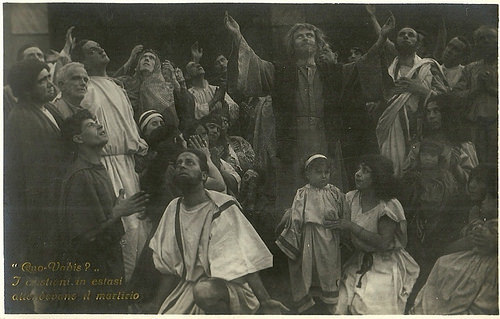
Italian postcard by G.G. Falci, Milano / La Fotominio. Photo: UCI (Unione Cinematografica Italiana). Publicity still for Quo vadis? (Gabriellino D'Annunzio, Georg Jacoby, 1924). Caption: The Christians awaited their martyrdom in ecstasy.
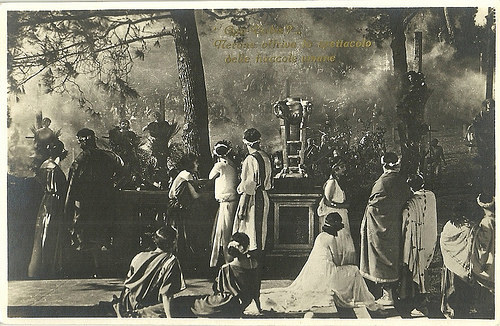
Italian postcard by G.G. Falci, Milano / La Fotominio, no. 156. Photo: UCI (Unione Cinematografica Italiana). Publicity still for Quo vadis? (Gabriellino D'Annunzio, Georg Jacoby, 1924). Caption: Nero offered the spectacle of the human torches.
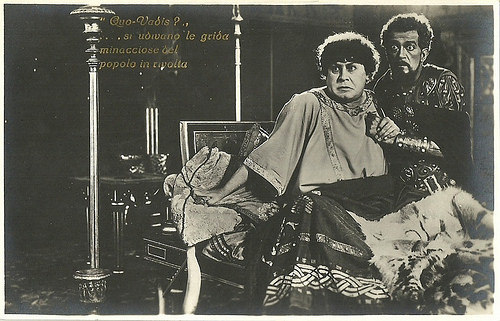
Italian postcard by G.G. Falci, Milano / La Fotominio, no. 159. Photo: UCI (Unione Cinematografica Italiana). Publicity still for Quo vadis? (Gabriellino D'Annunzio, Georg Jacoby, 1924). Caption: They heard the menacing shouts of the revolting mob. Shown are Emil Jannings as Nero and Raimondo Van Riel as Tigellinus. Actually, the scene refers to Nero's nightmare.
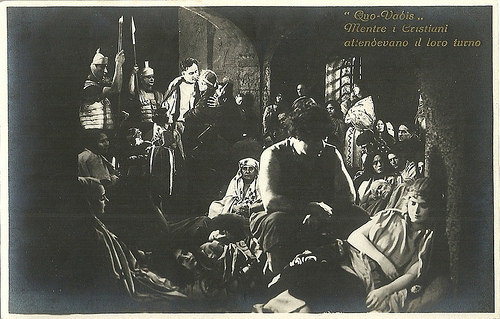
Italian postcard by G.G. Falci, Milano / La Fotominio, no. 163. Photo: UCI (Unione Cinematografica Italiana). Publicity still for Quo vadis? (Gabriellino D'Annunzio, Georg Jacoby, 1924). Caption: While the Christian were awaiting their turn. On the foreground, Ursus ( Bruto Castellani ) is guarding Licia ( Lilian Hall-Davis ). In the background the light falls on the family of Plautus, Domitilla ( Elga Brink ) and their son (Marcella Sabatini).
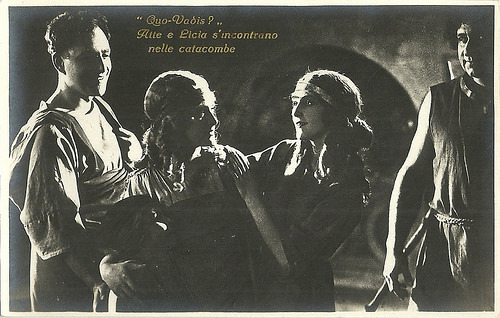
Italian postcard by G.G. Falci, Milano / La Fotominio, no. 165. Photo: UCI (Unione Cinematografica Italiana). Publicity still for Quo vadis? (Gabriellino D'Annunzio, Georg Jacoby, 1924). Caption: Acte and Licia meet again in the catacombs. (But actually, the caption is wrong. Here, Lygia ( Lilian Hall-Davis ) meets again Domitilla ( Elga Brink ), her husband Plautus (name unknown) and their son. On the right Ursus ( Bruto Castellani ).
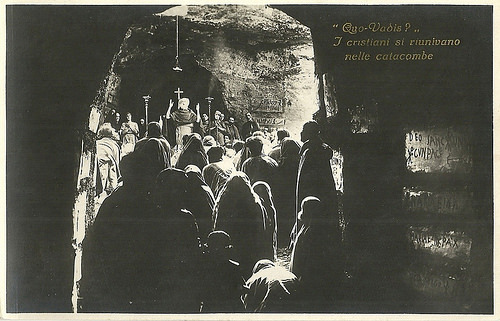
Italian postcard by G.G. Falci, Milano / La Fotominio, no. 168. Photo: UCI (Unione Cinematografica Italiana). Publicity still for Quo vadis? (Gabriellino D'Annunzio, Georg Jacoby, 1924). Caption: The Christians gathered in the catacombs.
Sources: Vittorio Martinelli, Il cinema muto italiano. I film degli anni venti, 1923-1931. Hal Erickson (AllMovie), Marcin Kukuczka (IMDb), Wikipedia and IMDb.

German postcard by Ross Verlag, no. 699/1, 1919-1924. Photo: Filmhaus Bruckmann. Publicity still for Quo vadis? (Georg Jacoby, Gabriellino D'Annunzio, 1924-1925). Here we see Nero ( Emil Jannings ) going out of his mind when his little son dies.

German postcard by Ross Verlag, no. 699/3, 1919-1924. Photo: Filmhaus Bruckmann. Publicity still for Quo vadis? (Georg Jacoby, Gabriellino D'Annunzio, 1924-1925). Here, Marcus Vinicius ( Alphons Fryland ) tries to seduce the chaste Lygia ( Lilian Hall-Davis ) during an orgy at Nero's palace.

German postcard by Ross Verlag, no. 699/4, 1919-1924. Photo: Filmhaus Bruckmann. Publicity still for Quo vadis? (Gabriellino D'Annunzio, Georg Jacoby, 1925). Marcus Vinicius ( Alphons Fryland ) leads the populace against Nero.

German postcard by Ross Verlag, no. 699/5, 1919-1924. Photo: Filmhaus Bruckmann. Publicity still for Quo vadis? (Georg Jacoby, Gabriellino D'Annunzio, 1924-1925). Here we see Ursus ( Bruto Castellani ) liberating Lygia ( Lilian Hall-Davis ) after he has conquered the raging bull. Castellani's face and hair are clearly drawn afterwards. In the film the nudity is only visible for a fraction of a second.

German postcard by Ross Verlag, Berlin, no. 699/6, 1919-1924. Photo: Filmhaus Brückmann. Publicity still for Quo vadis? (Gabriellino D'Annunzio, Georg Jacoby, 1924) with Rina De Liguoro as Eunice, secretly in love with her master Petronius ( André Habay ).
A huge spectacle
Ten years after the smashing success of director Enrico Guazzoni's colossal epic Quo vadis? (1913), the Unione Cinematografica Italiana (U.C.I.) decided to make a new silent film version.
The Unione Cinematografica Italiana was an Ufa-like or Universal-like merger of many Italian pre-war film companies. Grand old man Arturo Ambrosio was the producer of the third film version, Quo vadis? (1924-1925), and personally involved in the project from 1923.
Directors were the German Georg Jacoby and the Italian Gabriellino D' Annunzio, son of Gabriele D'Annunzio, the famous Italian writer and adventurer.
They turned Sienkiewicz's story of Emperor Nero's politically motivated persecution of the early Christians to hush up his own burning of Rome, and of the 'conversion' of an agnostic Roman warrior via the love of a virtuous Christian girl, into a huge spectacle.
Highlights are the 'burning of Rome' scenes and the climactic fights and carnage in the gladiatorial arena. Cinematography was by Giovanni Vitrotti, Alfredo Donelli, and Curt Courant.

Italian postcard by Ed. A. Traldi, Milano, no. 651. Photo: Lilian Hall-Davis as Licia/Lygia in Quo vadis? (Gabriellino D'Annunzio, Georg Jacoby, 1924-1925).

Italian postcard by Ed. G.B. Falci, Milano. Photo: Rina De Liguoro as Eunice in Quo vadis? (Gabriellino D' Annunzio, Georg Jacoby, 1924-1925).

Italian postcard by Ed. A. Traldi, Milano, no. 662. Photo: Elga Brink as Domitilla in Quo vadis? (Gabriellino D'Annunzio, Georg Jacoby, 1924-1925).

Italian postcard by Ed. A. Traldi, Milano, no. 663. Photo: Elena Sangro as the Empress Poppaea in Quo vadis? (Gabriellino D'Annunzio, Georg Jacoby, 1924-1925).
A Stellar Cast
The historical epic was shot in Rome with a stellar cast of international silent stars. One of the brightest stars of the British silent cinema, Lilian Hall-Davis , and Austrian actor Alphons Fryland played the two young lovers Lygia (Licia in Italian) and Marcus Vinicius.
The German actress Elga Brink appeared as Domitilla. She has a spectacular scene, when as Christian martyr she is first dragged by a chariot through the circus, but then manages to climb up the chariot, take the reins and finish the race, to the great joy of the audience. Italian actor André Habay portrayed Marcus' uncle Petronius, Nero's 'arbiter elegantiae', who uses his wit to flatter and mock him at the same time. Italian diva Rina De Liguoro played Petronius' slave Eunice who later on becomes his mistress and dies with him.
And then there was the famous star of the German silent cinema, Emil Jannings , who was cast as the emperor Nero. Hal Erickson at AllMovie : "Jannings tackles the role of Nero with lusty abandon, making this already larger-than-life historical personality even more so." While in the 1913 version Carlo Cattaneo gave a more naive version of Nero, more the victim of his surroundings, Jannings' Nero is clearly a perverse and sadistic man, who enjoys other people's misery, frightens and plays with his courtiers, and hypocritically offers Licia's his help after Vinicius has been too rough to her, only to reveal later on his own real, lustful intentions. It is also clear the filmmakers gave Jannings a much bigger part in the film than his predecessor or than in the novel. The publicity highlighted his presence as star of the film too.

Italian Postcard by Ed. A. Traldi, Milano, no. 665. Photo: Bruto Castellani as Ursus in Quo vadis? (Gabriellino D' Annunzio, Georg Jacoby, 1924-1925).

Italian postcard by Ed. Romeo Biagi, Bologna, no. 666. Photo: Unione Cinematografica Italiana. Alphons Fryland as Vinicius in Quo vadis? (Gabriellino D' Annunzio, Georg Jacoby, 1924-1925).

Italian postcard by Ed. A. Traldi, Milano, no. 667. Photo: André Habay as Petronius in Quo vadis? (Gabriellino D'Annunzio, Georg Jacoby, 1924-1925).

Italian postcard by Ed. A. Traldi, Milano, no. 668. Photo: Unione Cinematografica Italiano. Publicity still of Emil Jannings as Nero in Quo vadis? (Georg Jacoby, Gabriellino D'Annunzio, 1924-1925).

Italian postcard by Ed. A. Traldi, Milano, no. 669. Photo: Gino Viotti as the lecherous and treacherous Greek Chilo Chilonides in Quo vadis? (Gabriellino D'Annunzio, Georg Jacoby, 1924-1925).

Italian postcard by Ed. A. Traldi, Milano, no. 670. Photo: Raimondo Van Riel as Nero's evil general Tigellinus in Quo vadis? (Gabriellino D'Annunzio, Georg Jacoby, 1924-1925).
Streaks of Sadism and Nudity
Quo vadis? had its Roman premiere on 16 March 1925. The producer had tried to equal the earlier version of 1913, adding enormous sets, designed by sculptor and architect Armando Brasini, and streaks of sadism & nudity, some already present in the novel (e.g. the human torches), others added to attract audiences (e.g. a female fed to Nero's lampreys).
The 1925 version didn't have the worldwide success of Enrico Guazzoni's earlier film. For various reasons: people were a bit bored with epic films and the censor had ordered cuts, such as the too explicit scenes of orgy, violence and blood gulping. The producer almost went bankrupt over copyright claims he all had to pay.
It didn't help that the lion tamer Alfred Schneider was convicted because one of his circus lions had bitten and killed an extra.
Still a fascinating film, especially for the performances of Emil Jannings as the evil emperor Nero, Elena Sangro as the empress Poppaea and Bruto Castellani as the strong man Ursus. Castellani had performed the role before in the 1913 version of Quo vadis?
Hal Erickson at AllMovie: "Although not as much of a cinematic landmark as the 1913 version of Quo Vadis?, this 1924 Italian adaptation of the Henryk Sienkiewicz best-seller was a splendidly lavish production, not to mention a worldwide box-office success."

Italian postcard by Edizione L'Argentografica, Torino. Photo: UCI (Unione Cinematografica Italiana). Publicity still for Quo vadis? (Gabriellino D'Annunzio, Georg Jacoby, 1924).

Italian postcard by Edizione L'Argentografica, Torino. Photo: UCI (Unione Cinematografica Italiana). Publicity still for Quo vadis? (Gabriellino D'Annunzio, Georg Jacoby, 1924), starring Emil Jannings as Nero, and Elena Sangro as Poppaea. When Chilo exposes Nero as arsonist, the emperor shoots him.

Italian postcard by Edizione L'Argentografica, Torino. Photo: UCI (Unione Cinematografica Italiana). Publicity still for Quo vadis? (Gabriellino D'Annunzio, Georg Jacoby, 1924). Petronius (André Habay) greets Nero (Emil Jannings).

Italian postcard by Edizione L'Argentografica, Torino. Photo: UCI (Unione Cinematografica Italiana). Publicity still for Quo vadis? (Gabriellino D'Annunzio, Georg Jacoby, 1924), with Alphons Fryland as Vinicius.

Italian postcard by Edizione L'Argentografica, Torino. Photo: UCI (Unione Cinematografica Italiana). Publicity still for Quo vadis? (Gabriellino D'Annunzio, Georg Jacoby, 1924), with Marcella Sabatini, Lilian Hall-Davis as Lygia and Alphons Fryland as Vinicius.

Italian postcard by Edizione L'Argentografica, Torino. Photo: UCI (Unione Cinematografica Italiana). Publicity still for Quo vadis? (Gabriellino D'Annunzio, Georg Jacoby, 1924). The large architectural constructions of Nero's palace on the Palatine were by Armando Brasini, while R. Ferro and G. Spellani took care of the general production design.

Italian postcard by Edizione L'Argentografica, Torino. Photo: UCI (Unione Cinematografica Italiana). Publicity still for Quo vadis? (Gabriellino D'Annunzio, Georg Jacoby, 1924).

Italian postcard by Edizione L'Argentografica, Torino. Photo: UCI (Unione Cinematografica Italiana). Publicity still for Quo vadis? (Gabriellino D'Annunzio, Georg Jacoby, 1924). The soothsayer, explaining Nero's nightmare.
Magnificently Restored
Hal Erickson mentions at AllMovie that the subsequent Hollywood popularity of Emil Jannings prompted a reissue of Quo vadis? in 1929. Reportedly a newly recorded musical score was added.
In 1951 Hollywood made a new version with sound and in colour, Quo Vadis (Mervyn LeRoy, 1951). The film stars Robert Taylor, Deborah Kerr , Leo Genn , and Peter Ustinov. It was nominated for eight Academy Awards.
Fifty years later followed a Polish adaptation by Jerzy Kawalerowicz: Quo Vadis (2001). There was also a 1985 mini-series starring Klaus Maria Brandauer as Nero.
Also in 2001, the Dutch Filmmuseum (now Eye Institute) in Amsterdam restored the silent 1924 version of Quo vadis?, based on various existing copies. This magnificently restored version had its 're-premiere' at the Bologna film festival Cinema Ritrovato in 2002.

Italian postcard. Photo: UCI (Unione Cinematografica Italiana). Publicity still of the scene of the kidnapping of Lygia in Quo vadis? (Gabriellino D'Annunzio, Georg Jacoby, 1924-1925).

Italian postcard by G.G. Falci, Milano / La Fotominio. Photo: UCI (Unione Cinematografica Italiana). Publicity still for Quo vadis? (Gabriellino D'Annunzio, Georg Jacoby, 1924). Caption: The Christians awaited their martyrdom in ecstasy.

Italian postcard by G.G. Falci, Milano / La Fotominio, no. 156. Photo: UCI (Unione Cinematografica Italiana). Publicity still for Quo vadis? (Gabriellino D'Annunzio, Georg Jacoby, 1924). Caption: Nero offered the spectacle of the human torches.

Italian postcard by G.G. Falci, Milano / La Fotominio, no. 159. Photo: UCI (Unione Cinematografica Italiana). Publicity still for Quo vadis? (Gabriellino D'Annunzio, Georg Jacoby, 1924). Caption: They heard the menacing shouts of the revolting mob. Shown are Emil Jannings as Nero and Raimondo Van Riel as Tigellinus. Actually, the scene refers to Nero's nightmare.

Italian postcard by G.G. Falci, Milano / La Fotominio, no. 163. Photo: UCI (Unione Cinematografica Italiana). Publicity still for Quo vadis? (Gabriellino D'Annunzio, Georg Jacoby, 1924). Caption: While the Christian were awaiting their turn. On the foreground, Ursus ( Bruto Castellani ) is guarding Licia ( Lilian Hall-Davis ). In the background the light falls on the family of Plautus, Domitilla ( Elga Brink ) and their son (Marcella Sabatini).

Italian postcard by G.G. Falci, Milano / La Fotominio, no. 165. Photo: UCI (Unione Cinematografica Italiana). Publicity still for Quo vadis? (Gabriellino D'Annunzio, Georg Jacoby, 1924). Caption: Acte and Licia meet again in the catacombs. (But actually, the caption is wrong. Here, Lygia ( Lilian Hall-Davis ) meets again Domitilla ( Elga Brink ), her husband Plautus (name unknown) and their son. On the right Ursus ( Bruto Castellani ).

Italian postcard by G.G. Falci, Milano / La Fotominio, no. 168. Photo: UCI (Unione Cinematografica Italiana). Publicity still for Quo vadis? (Gabriellino D'Annunzio, Georg Jacoby, 1924). Caption: The Christians gathered in the catacombs.
Sources: Vittorio Martinelli, Il cinema muto italiano. I film degli anni venti, 1923-1931. Hal Erickson (AllMovie), Marcin Kukuczka (IMDb), Wikipedia and IMDb.
Published on November 14, 2016 22:00
November 13, 2016
Quo vadis? (1913)
Yesterday, an exhibition on the transmediality of Quo vadis? opened in Rome, Italy. Quo vadis? is the famous novel for which Henryk Sienkiewicz got the Nobel Prize. Today, 14 November, and tomorrow, 15 November, there is also a conference in Rome with a keynote lecture by Maria Wyke, one of the most renowned experts in cinema and Antiquity. Several film versions of Quo vadis? will be screened in Rome, including the newly restored 1901 version by Pathé Frères. EFSP posts two film specials on Quo vadis? adaptations. Tomorrow you'll find here dozens of postcards of the famous 1924 version with Emil Jannings as Nero, and today a post on the colossal epic of 1913, starring Amleto Novelli and Gustavo Serena.
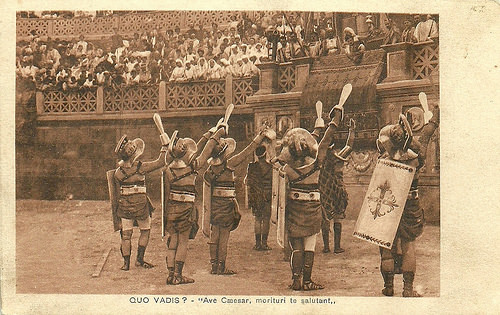
Italian postcard. Photo: Cines. Publicity still for Quo vadis? (Enrico Guazzoni, 1913). Caption: "Ave Caesar, those who are about to die salute you." This image cites a famous 19th century painting (1859) by Jean-Léon Gérôme. It was often quoted, also in the Asterix comics.
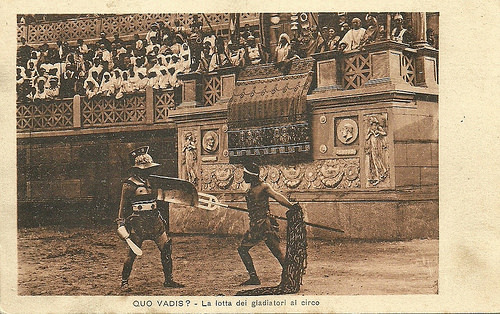
Italian postcard. Photo: Cines. Publicity still for Quo vadis? (Enrico Guazzoni, 1913). Caption: The fight of the gladiators in the arena.
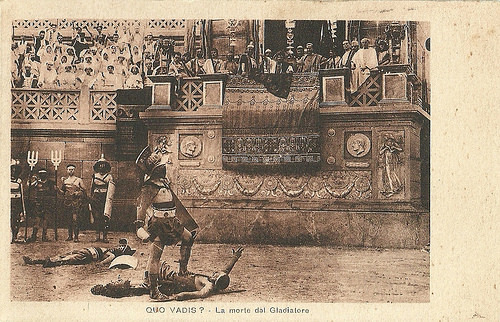
Italian postcard. Photo: Cines. Publicity still for Quo vadis? (Enrico Guazzoni, 1913). Caption: The death of the gladiator. This image cites Jean-Léon Gérôme's famous painting Pollice verso (Thumbs down, 1872) and was often used in the publicity for the film. In the back the emperor Nero (Carlo Cattaneo) makes the sign of thumbs down, sign for the conqueror to kill his adversary. Flanking Nero are left Tigellinus (Cesare Moltroni) and right Petronius ( Gustavo Serena ). Left of the imperial box the Vestal Virgins are seated.
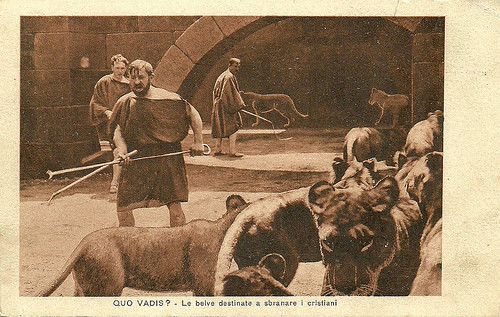
Italian postcard. Photo: Cines. Publicity still for Quo vadis? (Enrico Guazzoni, 1913). Caption: The wild animals destined to tear the Christians to pieces. The lion keepers activate the lions under the circus before sending them above ground.
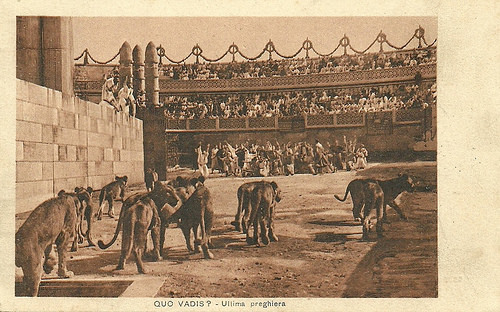
Italian postcard. Photo: Cines. Publicity still for Quo vadis? (Enrico Guazzoni, 1913). Caption: The last prayer. This scene quotes Jean-Léon Gérôme's painting The Christian Martyrs' Last Prayer (1863-1883).
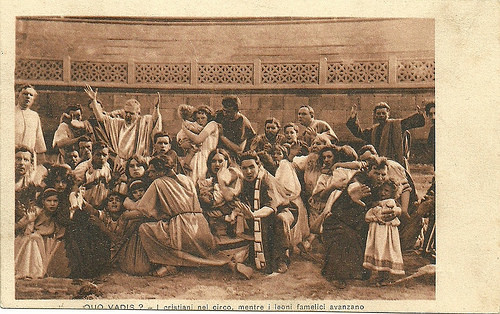
Italian postcard. Photo: Cines. Publicity still for Quo vadis? (Enrico Guazzoni, 1913). Caption: The Christians in the circus, while the hungry lions approach.
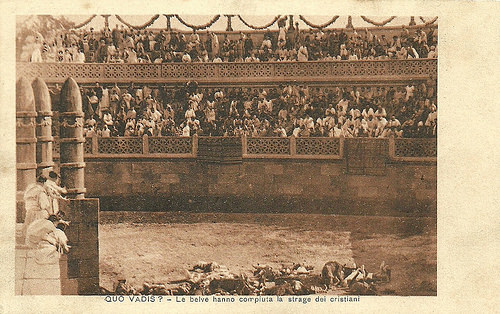
Italian postcard. Photo: Cines. Publicity still for Quo vadis? (Enrico Guazzoni, 1913). The beasts have committed the massacre of the Christians.
Where Are You Going?
Quo vadis? is Latin for 'Where are you going?' and alludes to the apocryphal acts of Peter, in which Peter flees Rome but on his way meets Jesus and asks him why he is going to Rome. Jesus says "I am going back to be crucified again", which makes Peter go back to Rome and accept martyrdom.
Quo vadis? written by Henryk Sienkiewicz tells the love story between a young and beautiful Christian woman, Lygia, and a military tribune and Roman patrician, Marcus Vinicius. The story takes place in the city of Rome under the rule of emperor Nero around AD 64.
Published in installments in three Polish dailies in 1895, Quo vadis? came out in book form in 1896 and has since been translated into more than 50 languages. This novel contributed to Sienkiewicz's Nobel Prize for literature in 1905.
In 1901, Pathé Frères produced the first screen version, Quo vadis? (Lucien Nonguet, Ferdinand Zecca, 1901). It is only 65 meters long (duration: about three minutes) and was recently restored by the Centre national du cinéma et de l’image animée (CNC) in Paris.
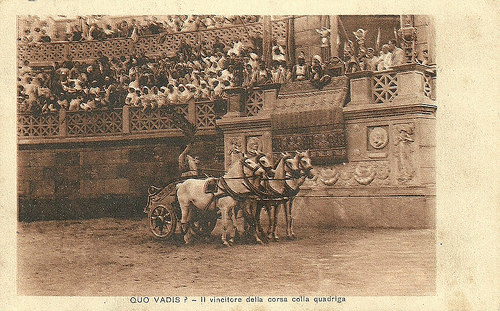
Italian postcard. Photo: Cines. Publicity still for Quo vadis? (Enrico Guazzoni, 1913). Caption: The winner of the chariot race.
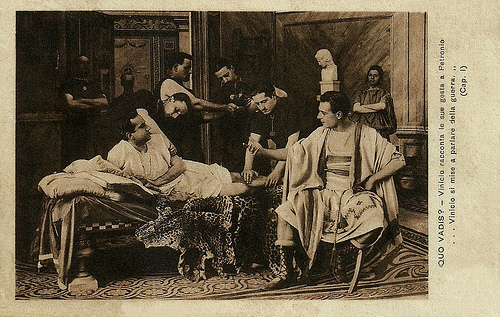
Italian postcard. Photo: Cines. Publicity still for Quo vadis? (Enrico Guazzoni, 1913). Gustavo Serena as Petronius Arbiter and Amleto Novelli as Marcus Vinicius. Caption: Vinicius tells Petronius of his acts. Vinicius started to talk about the war (Chapter I).
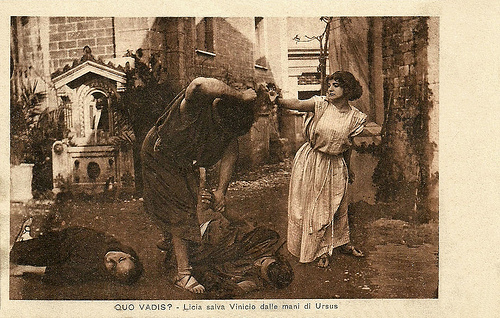
Italian postcard by Uff.Rev. St. Terni. Photo: Cines. Publicity still for Quo vadis? (Enrico Guazzoni, 1913). Lygia ( Lea Giunchi ) saves Vinicius ( Amleto Novelli ) from the hands of Ursus ( Bruto Castellani ). Ursus, protector of Lygia, has just killed a gladiator who had been charged by Vinicius to kill Ursus while he himself planned to abduct Lygia.
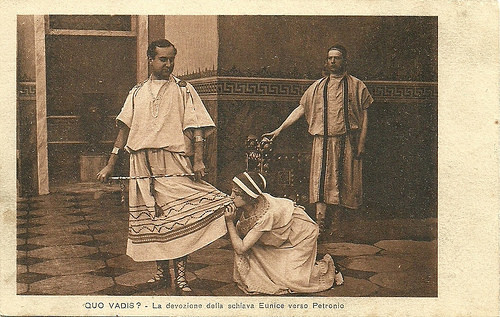
Italian postcard. Photo: Cines. Publicity still for Quo vadis? (Enrico Guazzoni, 1913). Caption: The devotion of the slave Eunice (Amelia Cattaneo) to Petronius ( Gustavo Serena ).
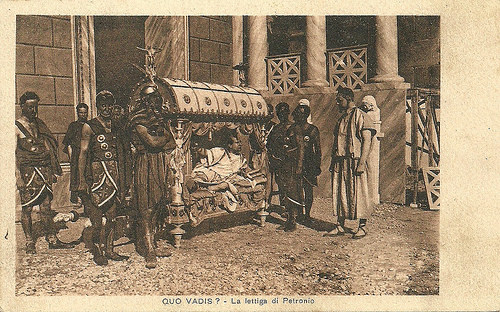
Italian postcard. Photo: Cines. Publicity still for Quo vadis? (Enrico Guazzoni, 1913). Caption: The litter of Petronius. In front of Nero's palace, Petronius ( Gustavo Serena ) says goodbye to his cousin Vinicius (Amleto Novelli) and promises to have a good word to Nero about Vinicius getting Lygia.
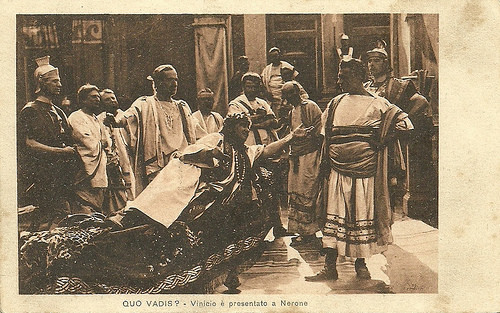
Italian postcard. Photo: Cines. Publicity still for Quo vadis? (Enrico Guazzoni, 1913). Caption: Vinicius ( Amleto Novelli ) is presented to Nero (Carlo Cattaneo). Behind Nero stands Petronius ( Gustavo Serena ).
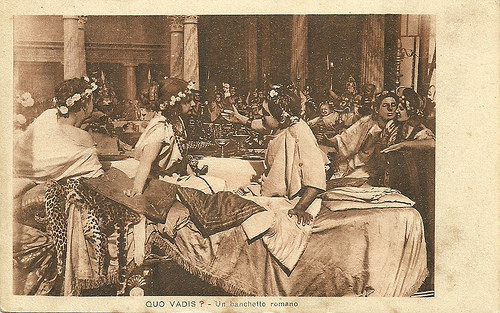
Italian postcard. Photo: Cines. Publicity still for Quo vadis? (Enrico Guazzoni, 1913). A Roman banquet. In the front Lea Giunchi as Lygia and Amleto Novelli as Vinicius.
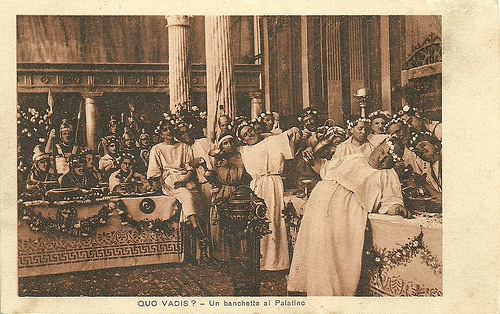
Italian postcard. Photo: Cines. Publicity still for Quo vadis? (Enrico Guazzoni, 1913). Caption: A banquet on the Palatine. The fat and drunken man in front is Giuseppe Gambardella (Vitellius), who was also famous as Checco in short Italian comedies.
A colossal epic
Ten years later, Italian director Enrico Guazzoni made a colossal epic starring Amleto Novelli and Gustavo Serena . He masterly combined huge spectacle with intimate scenes.
In 1913, Guazzoni's Quo vadis? premiered and the results at the box office quickly proved it a smashing success. Wikipedia : "It was arguably the first blockbuster in the history of cinema, with 5,000 extras, lavish sets, and a running time of two hours, setting the standard for 'superspectacles' for decades to come."
Throughout the world, Quo vadis? became popular not only among readers but also among fans of the new phenomenon, cinema. The film influenced Giovanni Pastrone's Cabiria 1914) and D.W. Griffith's Intolerance (1916).
Hal Erickson at AllMovie : "Quo Vadis? is nonetheless an important milestone in movie history. The film ran 12 reels (approximately three hours) at a time when most American productions were still within the 1- to 4-reel length. American film distributor George Kleine pared the film down to 8 reels for US distribution, but this still was an uncommonly long production for its day."
In 1997 the film was restored by the Dutch Filmmuseum (now Eye Institute) in Amsterdam and since then it was shown on several festivals. Tonight it will be screened in Rome.
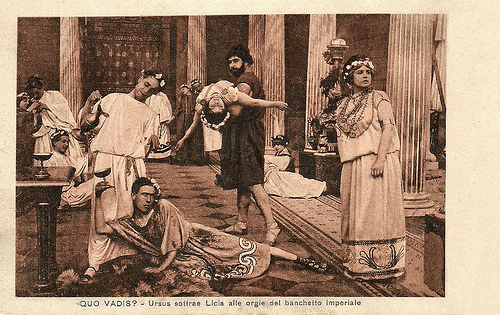
Italian postcard. Photo: Cines. Publicity still for Quo vadis? (Enrico Guazzoni, 1913). Helped by Acte, Nero's former mistress, Ursus ( Bruto Castellani ) subtracts Lygia ( Lea Giunchi ) from the orgy of the imperial banquet, where the drunken Roman Vinicius tries to rape her.
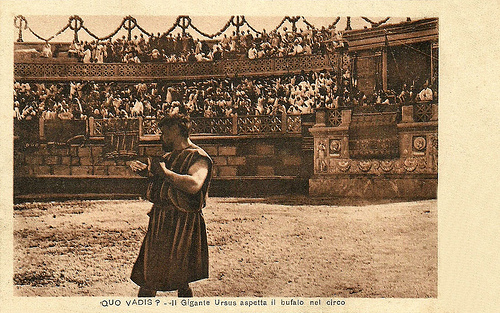
Italian postcard. Photo: Cines. Publicity still for Quo vadis? (Enrico Guazzoni, 1913). The Giant Ursus ( Bruto Castellani ) awaits the bull in the circus. After his long captivity Ursus is almost blinded when he enters the arena. Then a wild bull enters the arena on which back Lygia is bound. Ursus will kill the bull with his bare hands, much to the delight of the audience and the emperor.
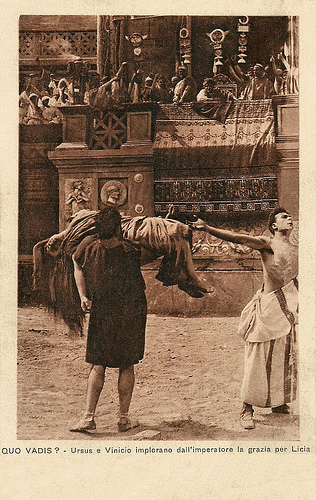
Italian postcard. Photo: Cines. Publicity still for Quo vadis? (Enrico Guazzoni, 1913). Ursus ( Bruto Castellani ) and Vinicius ( Amleto Novelli ) implore the audience and emperor Nero to grace the Christian Lygia ( Lea Giunchi ), after Ursus has killed the bull on whch back Lygia had been bound. The audience raves because of Ursus' tour de force. Vinicius has stripped his cloth to show his scars from the wars, while Ursus holds up Lygia. All around Nero hold their thumbs up for grace, even if this sign seems to have been a 19th century invention and historically incorrect.
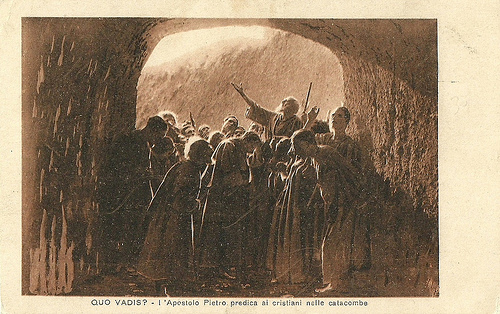
Italian postcard. Photo: Cines. Publicity still for Quo vadis? (Enrico Guazzoni, 1913). Caption: The apostle Peter (Giovanni Gizzi) preaching to the Christians in the catacombs.
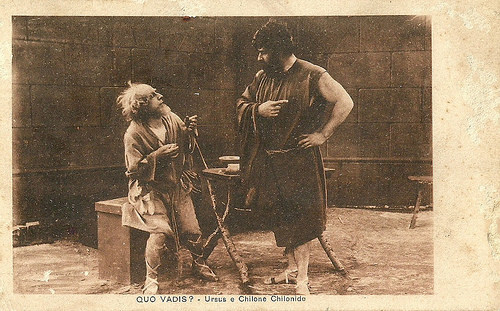
Italian postcard. Photo: Cines. Publicity still for Quo vadis? (Enrico Guazzoni, 1913). Caption: Ursus ( Bruto Castellani ) and Chilo Chilonides (Augusto Mastripietri).
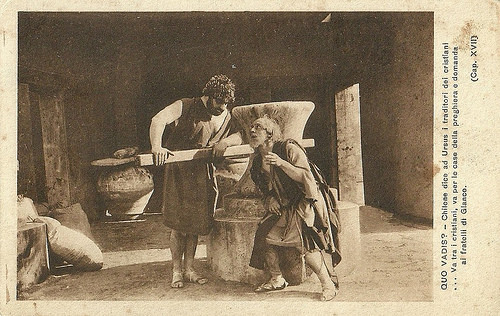
Italian postcard. Photo: Cines. Publicity still for Quo vadis? (Enrico Guazzoni, 1913). Chilo (Augusto Mastripietri) sweettalks to Ursus ( Bruto Castellani ) to find out where Lygia is hidden. Caption: Chilo talks to Ursus about the traitors of the Christians. (Ursus:) Go to the Christians, go to their godhouses and ask for the brothers of Glaucus. (Chapter XVII of the book).
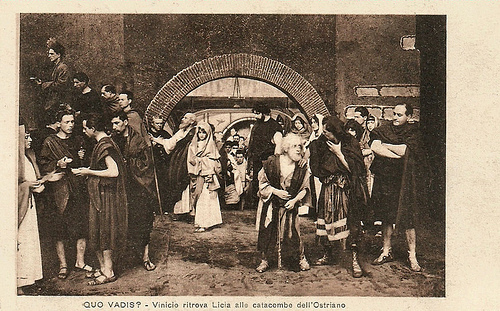
Italian postcard. Photo: Cines. Publicity still for Quo vadis? (Enrico Guazzoni, 1913). Vinicius ( Amleto Novelli ) finds back Lygia ( Lea Giunchi ) at the catacombs of Ostriano. Left of Lygia is St. Peter (Giovanni Gizzi), right of her protector Ursus ( Bruto Castellani ). Vinicius plots to abduct Lygia, with the help of the Greek Chilo (Augusto Mastripietri) and a gladiator.
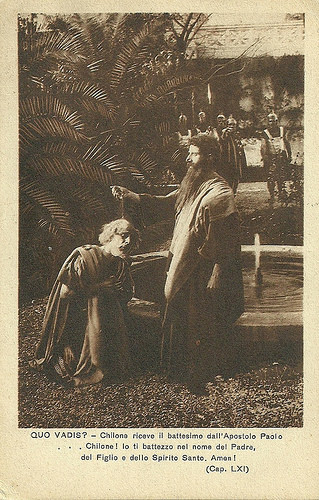
Italian postcard. Photo: Cines. Publicity still for Quo vadis? (Enrico Guazzoni, 1913). Caption: Chilo (Augusto Mastripietri) is baptised by the apostle Paul (of Tarsus). Chilon! I baptise you in the name of the Father, the Son and the Holy Ghost. Amen! (Chapter LXI of the book).
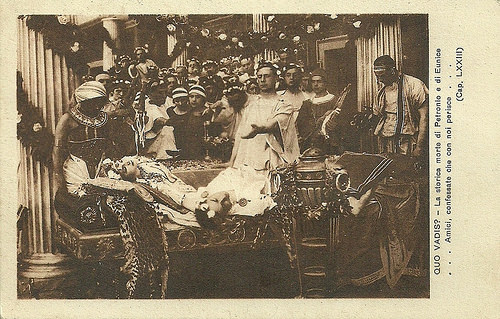
Italian postcard. Photo: Cines. Publicity still for Quo vadis? (Enrico Guazzoni, 1913). Caption: The historical death of Petronius ( Gustavo Serena ) and Eunice (Amelia Cattaneo). "Friends, confess that with us perishes..." (Chapter LXXIII).
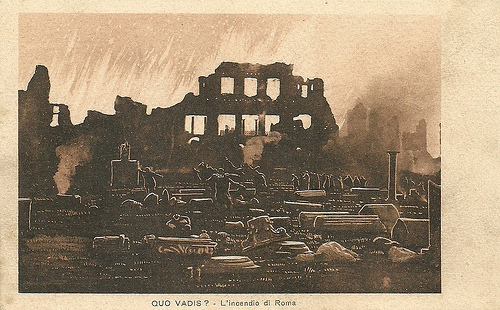
Italian postcard. Photo: Cines. Publicity still for Quo vadis? (Enrico Guazzoni, 1913). Caption: The fire of Rome.
Sources: Hal Erickson (AllMovie), Wikipedia and IMDb.

Italian postcard. Photo: Cines. Publicity still for Quo vadis? (Enrico Guazzoni, 1913). Caption: "Ave Caesar, those who are about to die salute you." This image cites a famous 19th century painting (1859) by Jean-Léon Gérôme. It was often quoted, also in the Asterix comics.

Italian postcard. Photo: Cines. Publicity still for Quo vadis? (Enrico Guazzoni, 1913). Caption: The fight of the gladiators in the arena.

Italian postcard. Photo: Cines. Publicity still for Quo vadis? (Enrico Guazzoni, 1913). Caption: The death of the gladiator. This image cites Jean-Léon Gérôme's famous painting Pollice verso (Thumbs down, 1872) and was often used in the publicity for the film. In the back the emperor Nero (Carlo Cattaneo) makes the sign of thumbs down, sign for the conqueror to kill his adversary. Flanking Nero are left Tigellinus (Cesare Moltroni) and right Petronius ( Gustavo Serena ). Left of the imperial box the Vestal Virgins are seated.

Italian postcard. Photo: Cines. Publicity still for Quo vadis? (Enrico Guazzoni, 1913). Caption: The wild animals destined to tear the Christians to pieces. The lion keepers activate the lions under the circus before sending them above ground.

Italian postcard. Photo: Cines. Publicity still for Quo vadis? (Enrico Guazzoni, 1913). Caption: The last prayer. This scene quotes Jean-Léon Gérôme's painting The Christian Martyrs' Last Prayer (1863-1883).

Italian postcard. Photo: Cines. Publicity still for Quo vadis? (Enrico Guazzoni, 1913). Caption: The Christians in the circus, while the hungry lions approach.

Italian postcard. Photo: Cines. Publicity still for Quo vadis? (Enrico Guazzoni, 1913). The beasts have committed the massacre of the Christians.
Where Are You Going?
Quo vadis? is Latin for 'Where are you going?' and alludes to the apocryphal acts of Peter, in which Peter flees Rome but on his way meets Jesus and asks him why he is going to Rome. Jesus says "I am going back to be crucified again", which makes Peter go back to Rome and accept martyrdom.
Quo vadis? written by Henryk Sienkiewicz tells the love story between a young and beautiful Christian woman, Lygia, and a military tribune and Roman patrician, Marcus Vinicius. The story takes place in the city of Rome under the rule of emperor Nero around AD 64.
Published in installments in three Polish dailies in 1895, Quo vadis? came out in book form in 1896 and has since been translated into more than 50 languages. This novel contributed to Sienkiewicz's Nobel Prize for literature in 1905.
In 1901, Pathé Frères produced the first screen version, Quo vadis? (Lucien Nonguet, Ferdinand Zecca, 1901). It is only 65 meters long (duration: about three minutes) and was recently restored by the Centre national du cinéma et de l’image animée (CNC) in Paris.

Italian postcard. Photo: Cines. Publicity still for Quo vadis? (Enrico Guazzoni, 1913). Caption: The winner of the chariot race.

Italian postcard. Photo: Cines. Publicity still for Quo vadis? (Enrico Guazzoni, 1913). Gustavo Serena as Petronius Arbiter and Amleto Novelli as Marcus Vinicius. Caption: Vinicius tells Petronius of his acts. Vinicius started to talk about the war (Chapter I).

Italian postcard by Uff.Rev. St. Terni. Photo: Cines. Publicity still for Quo vadis? (Enrico Guazzoni, 1913). Lygia ( Lea Giunchi ) saves Vinicius ( Amleto Novelli ) from the hands of Ursus ( Bruto Castellani ). Ursus, protector of Lygia, has just killed a gladiator who had been charged by Vinicius to kill Ursus while he himself planned to abduct Lygia.

Italian postcard. Photo: Cines. Publicity still for Quo vadis? (Enrico Guazzoni, 1913). Caption: The devotion of the slave Eunice (Amelia Cattaneo) to Petronius ( Gustavo Serena ).

Italian postcard. Photo: Cines. Publicity still for Quo vadis? (Enrico Guazzoni, 1913). Caption: The litter of Petronius. In front of Nero's palace, Petronius ( Gustavo Serena ) says goodbye to his cousin Vinicius (Amleto Novelli) and promises to have a good word to Nero about Vinicius getting Lygia.

Italian postcard. Photo: Cines. Publicity still for Quo vadis? (Enrico Guazzoni, 1913). Caption: Vinicius ( Amleto Novelli ) is presented to Nero (Carlo Cattaneo). Behind Nero stands Petronius ( Gustavo Serena ).

Italian postcard. Photo: Cines. Publicity still for Quo vadis? (Enrico Guazzoni, 1913). A Roman banquet. In the front Lea Giunchi as Lygia and Amleto Novelli as Vinicius.

Italian postcard. Photo: Cines. Publicity still for Quo vadis? (Enrico Guazzoni, 1913). Caption: A banquet on the Palatine. The fat and drunken man in front is Giuseppe Gambardella (Vitellius), who was also famous as Checco in short Italian comedies.
A colossal epic
Ten years later, Italian director Enrico Guazzoni made a colossal epic starring Amleto Novelli and Gustavo Serena . He masterly combined huge spectacle with intimate scenes.
In 1913, Guazzoni's Quo vadis? premiered and the results at the box office quickly proved it a smashing success. Wikipedia : "It was arguably the first blockbuster in the history of cinema, with 5,000 extras, lavish sets, and a running time of two hours, setting the standard for 'superspectacles' for decades to come."
Throughout the world, Quo vadis? became popular not only among readers but also among fans of the new phenomenon, cinema. The film influenced Giovanni Pastrone's Cabiria 1914) and D.W. Griffith's Intolerance (1916).
Hal Erickson at AllMovie : "Quo Vadis? is nonetheless an important milestone in movie history. The film ran 12 reels (approximately three hours) at a time when most American productions were still within the 1- to 4-reel length. American film distributor George Kleine pared the film down to 8 reels for US distribution, but this still was an uncommonly long production for its day."
In 1997 the film was restored by the Dutch Filmmuseum (now Eye Institute) in Amsterdam and since then it was shown on several festivals. Tonight it will be screened in Rome.

Italian postcard. Photo: Cines. Publicity still for Quo vadis? (Enrico Guazzoni, 1913). Helped by Acte, Nero's former mistress, Ursus ( Bruto Castellani ) subtracts Lygia ( Lea Giunchi ) from the orgy of the imperial banquet, where the drunken Roman Vinicius tries to rape her.

Italian postcard. Photo: Cines. Publicity still for Quo vadis? (Enrico Guazzoni, 1913). The Giant Ursus ( Bruto Castellani ) awaits the bull in the circus. After his long captivity Ursus is almost blinded when he enters the arena. Then a wild bull enters the arena on which back Lygia is bound. Ursus will kill the bull with his bare hands, much to the delight of the audience and the emperor.

Italian postcard. Photo: Cines. Publicity still for Quo vadis? (Enrico Guazzoni, 1913). Ursus ( Bruto Castellani ) and Vinicius ( Amleto Novelli ) implore the audience and emperor Nero to grace the Christian Lygia ( Lea Giunchi ), after Ursus has killed the bull on whch back Lygia had been bound. The audience raves because of Ursus' tour de force. Vinicius has stripped his cloth to show his scars from the wars, while Ursus holds up Lygia. All around Nero hold their thumbs up for grace, even if this sign seems to have been a 19th century invention and historically incorrect.

Italian postcard. Photo: Cines. Publicity still for Quo vadis? (Enrico Guazzoni, 1913). Caption: The apostle Peter (Giovanni Gizzi) preaching to the Christians in the catacombs.

Italian postcard. Photo: Cines. Publicity still for Quo vadis? (Enrico Guazzoni, 1913). Caption: Ursus ( Bruto Castellani ) and Chilo Chilonides (Augusto Mastripietri).

Italian postcard. Photo: Cines. Publicity still for Quo vadis? (Enrico Guazzoni, 1913). Chilo (Augusto Mastripietri) sweettalks to Ursus ( Bruto Castellani ) to find out where Lygia is hidden. Caption: Chilo talks to Ursus about the traitors of the Christians. (Ursus:) Go to the Christians, go to their godhouses and ask for the brothers of Glaucus. (Chapter XVII of the book).

Italian postcard. Photo: Cines. Publicity still for Quo vadis? (Enrico Guazzoni, 1913). Vinicius ( Amleto Novelli ) finds back Lygia ( Lea Giunchi ) at the catacombs of Ostriano. Left of Lygia is St. Peter (Giovanni Gizzi), right of her protector Ursus ( Bruto Castellani ). Vinicius plots to abduct Lygia, with the help of the Greek Chilo (Augusto Mastripietri) and a gladiator.

Italian postcard. Photo: Cines. Publicity still for Quo vadis? (Enrico Guazzoni, 1913). Caption: Chilo (Augusto Mastripietri) is baptised by the apostle Paul (of Tarsus). Chilon! I baptise you in the name of the Father, the Son and the Holy Ghost. Amen! (Chapter LXI of the book).

Italian postcard. Photo: Cines. Publicity still for Quo vadis? (Enrico Guazzoni, 1913). Caption: The historical death of Petronius ( Gustavo Serena ) and Eunice (Amelia Cattaneo). "Friends, confess that with us perishes..." (Chapter LXXIII).

Italian postcard. Photo: Cines. Publicity still for Quo vadis? (Enrico Guazzoni, 1913). Caption: The fire of Rome.
Sources: Hal Erickson (AllMovie), Wikipedia and IMDb.
Published on November 13, 2016 22:00
November 12, 2016
Robert Vaughn (1932-2016)
Last Friday, American actor Robert Vaughn died after a brief battle with acute leukaemia. Vaughn's elegant, dark-haired Napoleon Solo on the Spy series The Man from U.N.C.L.E (1964-1968) was television’s answer to James Bond. Together with his partner in the series, David McCallum as blond Russian Illya Kuryakin, Vaughn set 1960s TV’s standard for suavity and crime busting cool. The serie’s international popularity led to back-to-back of Golden Globe nominations for Vaughn as Best TV Star in 1965-1966.

American postcard by C.G. Williams Ltd, Maidstone, Kent, no. U 1, U.N.C.L.E. agent Napoleon Solo. Publicity still for The Man from U.N.C.L.E (1964-1968).
One of the Magnificent Seven
Robert Francis Vaughn was born in 1932 in New York City, to Gerald Walter Vaughn, a radio actor, and his wife, Marcella Frances (Gaudel), a stage actress. His ancestry included Irish, French, and German.
He studied journalism at the University of Minnesota, but quit after a year. He moved to Los Angeles and enrolled in Los Angeles City College majoring in drama, then he transferred to California State University at Los Angeles and completed his Master's degree. After that, and while he was acting throughout the 1960s and into the 1970s, he attended the University of Southern California and completed his Ph.D. in Communications. His thesis on the blacklisting of Hollywood entertainers during the McCarthy anti-communist era was published in 1972 as Only Victims.
His first film appearance was as an uncredited extra in The Ten Commandments (Cecil B. DeMille, 1956). Several parts in TV series and a role in the Western Good Day for a Hanging (Nathan Juran, 1959) followed.
Vaughn had his breakthrough as war veteran Chester A. Gwynn in The Young Philadelphians (Vincent Sherman, 1959), starring Paul Newman. For this part he was nominated for an Academy Award for Best Supporting Actor and won a Golden Globe for Best Supporting Actor.
He then played one of the seven gunfighters who help oppressed Mexican peasants to defend their homes in The Magnificent Seven (John Sturges, 1960). It earned him another Globe nomination for Most Promising Newcomer.
Daniel Bolton at IMDb : "Despite being in such popular films, he generally found work on television. He appeared over 200 times in guest roles in the late 1950s to early 1960s. It was in 1963 that he received his first major role in The Lieutenant (1963). Robert took the role with the intention of making the transition from being a guest-star actor to being a co-star on television. It was due to his work in this series that producer Norman Felton offered him the role of Napoleon Solo in The Man from U.N.C.L.E. (1964).
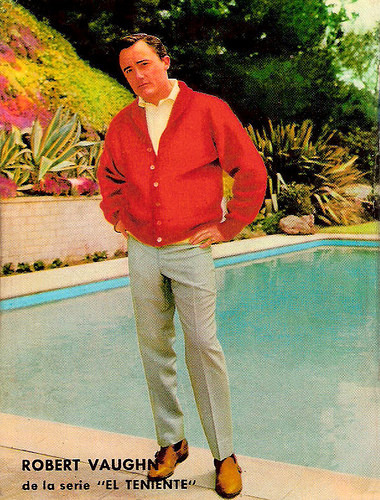
Spanish collectors card. Photo: publicity still for the series The Lieutenant (1963-1964).
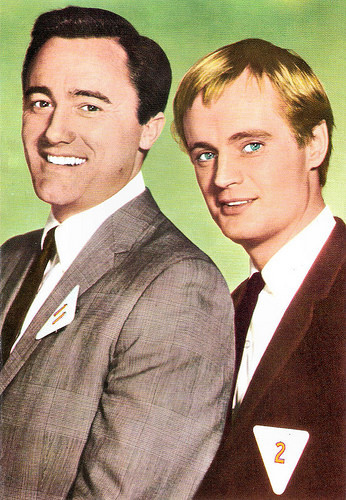
Spanish postcard by Bergas, no. 773. Photo: publicity still for the TV series The Man from U.N.C.L.E. (1964-1968) with David McCallum.
Computer villain
In the following decades, Robert Vaughn had memorable parts in such popular pictures as the Steve McQueen car-chase classic Bullitt (Peter Yates, 1968), the war film The Bridge at Remagen (John Guillermin, 1969), The Towering Inferno (John Guillermin, 1974) with Paul Newman and Steve McQueen, S.O.B. (Blake Edwards, 1981), Superman III (Richard Lester, 1983) and as the uncredited voice of Proteus IV, the computer villain of Demon Seed (Donald Cammell, 1977) with Julie Christie .
He also appeared in several European productions, such as the thriller La baby sitter (René Clément, 1975) with Maria Schneider, the adventure film Atraco en la jungla/Double Cross (Gordon Hessler, 1976), and the Spaghetti Western Renegade (E.B. Clucher, 1987) starring Terence Hill .
In television, he appeared in many successful series, most notably in The A-Team (1983) and Emerald Point N.A.S. (1983).
More recently, Vaughn played grifter and card sharp Albert Stroller on the British series Hustle (2004-2012). During the first two months of 2012, he took on the role of Milton Fanshaw in the long-running British soap opera Coronation Street, as Milton Fanshaw, a love interest for Sylvia Goodwin, played by veteran English actress Stephanie Cole.
His memoir, A Fortunate Life, was published in 2009. His final film was Gold Star (Vitoria Negri, 2016) about a young music school dropout, who struggles to make sense of her aimless life while caring for her dying 90 year old father.
Robert Vaughn died of acute leukaemia on 11 November 2016 in Ridgefield, Connecticut. He was 83. Vaughn is survived by wife, Linda Staab, and their two adopted children: Cassidy Vaughn (1976) and Caitlin Vaughn (1981).
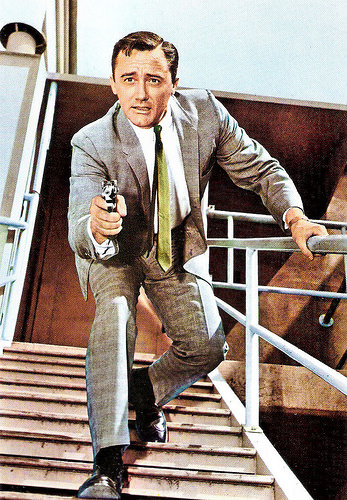
Spanish postcard by Bergas, no. 918. Photo: publicity still for The Man from U.N.C.L.E. (1964-1968).
Compilation Napoleon Solo -The Tough Life of an Uncle Agent of The Man from U.N.C.L.E. (1964-1968). Source: Tronyfree (YouTube).
Sources: Greg Evans and Erik Pedersen (Deadline), (IMDb), Wikipedia and .

American postcard by C.G. Williams Ltd, Maidstone, Kent, no. U 1, U.N.C.L.E. agent Napoleon Solo. Publicity still for The Man from U.N.C.L.E (1964-1968).
One of the Magnificent Seven
Robert Francis Vaughn was born in 1932 in New York City, to Gerald Walter Vaughn, a radio actor, and his wife, Marcella Frances (Gaudel), a stage actress. His ancestry included Irish, French, and German.
He studied journalism at the University of Minnesota, but quit after a year. He moved to Los Angeles and enrolled in Los Angeles City College majoring in drama, then he transferred to California State University at Los Angeles and completed his Master's degree. After that, and while he was acting throughout the 1960s and into the 1970s, he attended the University of Southern California and completed his Ph.D. in Communications. His thesis on the blacklisting of Hollywood entertainers during the McCarthy anti-communist era was published in 1972 as Only Victims.
His first film appearance was as an uncredited extra in The Ten Commandments (Cecil B. DeMille, 1956). Several parts in TV series and a role in the Western Good Day for a Hanging (Nathan Juran, 1959) followed.
Vaughn had his breakthrough as war veteran Chester A. Gwynn in The Young Philadelphians (Vincent Sherman, 1959), starring Paul Newman. For this part he was nominated for an Academy Award for Best Supporting Actor and won a Golden Globe for Best Supporting Actor.
He then played one of the seven gunfighters who help oppressed Mexican peasants to defend their homes in The Magnificent Seven (John Sturges, 1960). It earned him another Globe nomination for Most Promising Newcomer.
Daniel Bolton at IMDb : "Despite being in such popular films, he generally found work on television. He appeared over 200 times in guest roles in the late 1950s to early 1960s. It was in 1963 that he received his first major role in The Lieutenant (1963). Robert took the role with the intention of making the transition from being a guest-star actor to being a co-star on television. It was due to his work in this series that producer Norman Felton offered him the role of Napoleon Solo in The Man from U.N.C.L.E. (1964).

Spanish collectors card. Photo: publicity still for the series The Lieutenant (1963-1964).

Spanish postcard by Bergas, no. 773. Photo: publicity still for the TV series The Man from U.N.C.L.E. (1964-1968) with David McCallum.
Computer villain
In the following decades, Robert Vaughn had memorable parts in such popular pictures as the Steve McQueen car-chase classic Bullitt (Peter Yates, 1968), the war film The Bridge at Remagen (John Guillermin, 1969), The Towering Inferno (John Guillermin, 1974) with Paul Newman and Steve McQueen, S.O.B. (Blake Edwards, 1981), Superman III (Richard Lester, 1983) and as the uncredited voice of Proteus IV, the computer villain of Demon Seed (Donald Cammell, 1977) with Julie Christie .
He also appeared in several European productions, such as the thriller La baby sitter (René Clément, 1975) with Maria Schneider, the adventure film Atraco en la jungla/Double Cross (Gordon Hessler, 1976), and the Spaghetti Western Renegade (E.B. Clucher, 1987) starring Terence Hill .
In television, he appeared in many successful series, most notably in The A-Team (1983) and Emerald Point N.A.S. (1983).
More recently, Vaughn played grifter and card sharp Albert Stroller on the British series Hustle (2004-2012). During the first two months of 2012, he took on the role of Milton Fanshaw in the long-running British soap opera Coronation Street, as Milton Fanshaw, a love interest for Sylvia Goodwin, played by veteran English actress Stephanie Cole.
His memoir, A Fortunate Life, was published in 2009. His final film was Gold Star (Vitoria Negri, 2016) about a young music school dropout, who struggles to make sense of her aimless life while caring for her dying 90 year old father.
Robert Vaughn died of acute leukaemia on 11 November 2016 in Ridgefield, Connecticut. He was 83. Vaughn is survived by wife, Linda Staab, and their two adopted children: Cassidy Vaughn (1976) and Caitlin Vaughn (1981).

Spanish postcard by Bergas, no. 918. Photo: publicity still for The Man from U.N.C.L.E. (1964-1968).
Compilation Napoleon Solo -The Tough Life of an Uncle Agent of The Man from U.N.C.L.E. (1964-1968). Source: Tronyfree (YouTube).
Sources: Greg Evans and Erik Pedersen (Deadline), (IMDb), Wikipedia and .
Published on November 12, 2016 22:00
November 11, 2016
Imported from the USA: Errol Flynn
Australian born actor Errol Flynn (1909-1959) achieved fame in Hollywood with his suave, debonair, devil-may-care attitude. He was known for his romantic Swashbuckler roles in films like Captain Blood (1935) and The Adventures of Robin Hood (1938), often co-starring with Olivia de Havilland. In 1942, the tall, athletic and exceptionally handsome, Flynn became an American citizen. He developed a reputation for womanising, hard drinking and for a time in the 1940s, narcotics abuse. He was linked romantically with Lupe Vélez, Marlene Dietrich, and Dolores del Río, among many others.
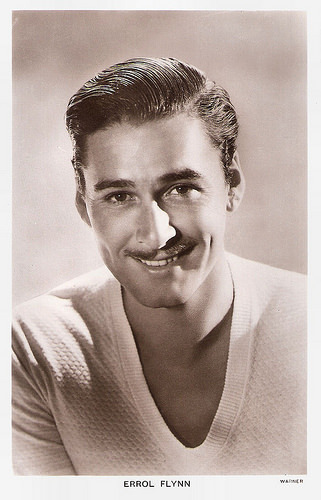
British postcard in the Picturegoer Series, no. 1301. Photo: Warner Bros.
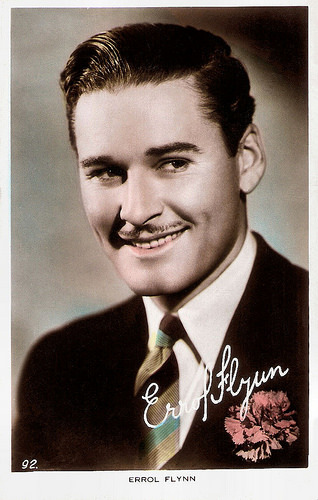
British postcard by Art Photo, no. 92.
Pilfering petty cash
Errol Leslie Thomson Flynn was born in a suburb of Hobart, Tasmania, in 1909. His father, Theodore Flynn, was a lecturer and later professor of biology at the University of Tasmania. His mother was Lily Mary Young. After early schooling in Hobart, from 1923 to 1925 Flynn was educated at the South West London College, a private boarding school in Barnes, London.
In 1926 he returned to Australia to attend Sydney Church of England Grammar School (Shore School) where he was the classmate of a future Australian prime minister, John Gorton. His formal education ended with his expulsion from Shore for theft. After being dismissed from a job as a junior clerk with a Sydney shipping company for pilfering petty cash, he went to Papua New Guinea at the age of eighteen, seeking his fortune in tobacco planting and metals mining.
Flynn spent the next five years oscillating between the New Guinea frontier territory and Sydney. In early 1933, Flynn appeared as an amateur actor in the low-budget Australian film In the Wake of the Bounty (Charles Chauvel, 1933), in the lead role of Fletcher Christian.
Later that year he returned to Britain to pursue a career in acting, and soon secured a job with the Northampton Repertory Company at the town's Royal Theatre, where he worked and received his training as a professional actor for seven months. In 1934 Flynn was dismissed from Northampton Rep. reportedly after he threw a female stage manager down a stairwell.
He returned to Warner Brothers' Teddington Studios in Middlesex where he had worked as an extra in the film I Adore You (George King, 1933) before going to Northampton. With his new-found acting skills, he was cast as the lead in Murder at Monte Carlo (Ralph Ince, 1935), now considered a lost film. During its filming he was spotted by a talent scout for Warner Bros. and Flynn emigrated to the U.S. as a contract actor.
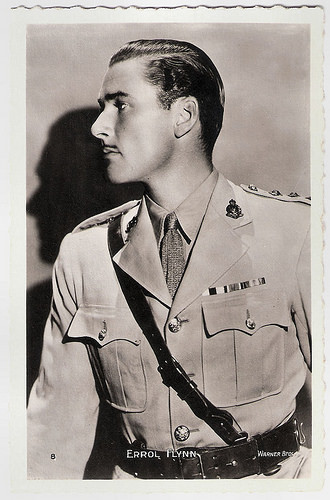
French postcard by Editions Chantal, Rueil-Malmaison, no. 8. Photo: Warner Bros. Publicity still for Another Dawn (William Dieterle, 1937).
Striking Good Looks
In Hollywood, Errol Flynn was first cast in two insignificant films, but then he got his great chance. He could replace Robert Donat in the title role of Captain Blood (Michael Curtiz, 1935). Flynn's natural athletic talent and good looks rocketed him overnight to international stardom.
Over the next six years, he was typecast as a dashing adventurer in The Charge of the Light Brigade (Michael Curtiz, 1936), The Prince and the Pauper (William Keighley, 1937), The Adventures of Robin Hood (Michael Curtiz, William Keighley, 1938; his first Technicolor film), The Dawn Patrol (Edmund Goulding, 1938) with David Niven , Dodge City (Michael Curtiz, 1939), The Private Lives of Elizabeth and Essex (Michael Curtiz, 1939) and The Sea Hawk (Michael Curtiz, 1940).
His striking good looks and screen charisma won him millions of fans. Flynn played an integral role in the re-invention of the action-adventure genre. In collaboration with Hollywood's best fight arrangers, Flynn became noted for fast-paced sword fights. He demonstrated an acting range beyond action-adventure roles in light contemporary social comedies, such as The Perfect Specimen (Michael Curtiz, 1937) and Four's a Crowd (Michael Curtiz, 1938), and melodrama The Sisters (Anatole Litvak, 1938).
During this period Flynn published his first book, Beam Ends (1937), an autobiographical account of his sailing experiences around Australia as a youth. He also travelled to Spain, in 1937, as a war correspondent during the Spanish Civil War.
Flynn co-starred with Olivia de Havilland a total of eight times, and together they made the most successful on-screen romantic partnership in Hollywood in the late 1930s-early 1940s in eight films. Flynn's relationship with Bette Davis, his co-star in The Private Lives of Elizabeth and Essex (Michael Curtiz, 1939), was quarrelsome. Davis allegedly slapped him across the face far harder than necessary during one scene.
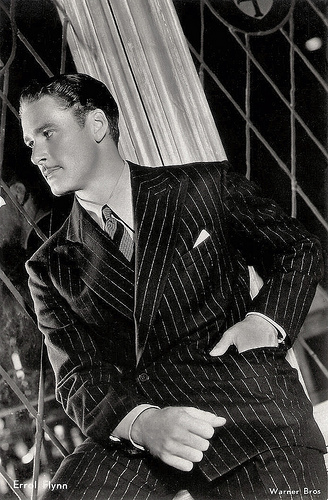
Dutch postcard by M.B.&Z., no. 1050. Photo: Warner Bros.
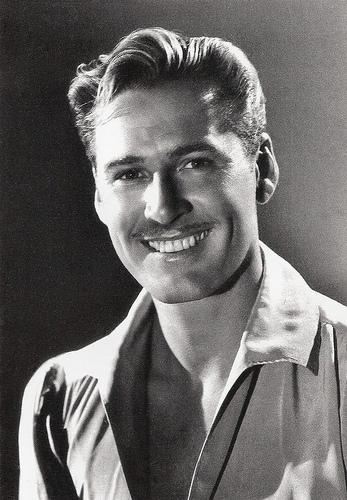
German postcard by Edition Cicero, Hamburg, no. 150/10. Photo: Elmer Fryer, 1936 / The Kobal Collection.
Paragon of male physical prowess
In 1940, at the zenith of his career, Erroll Flynn was voted the fourth most popular star in the US. Flynn became a naturalised American citizen in 1942. As the United States had by then entered the Second World War, he attempted to enlist in the armed services, but failed the physical exam due to multiple heart problems and other diseases.
This created an image problem for both Flynn, the supposed paragon of male physical prowess, and for Warner Brothers, which continued to cast him in athletic roles, including such patriotic productions as Dive Bomber (Michael Curtiz, 1941), Desperate Journey (Raoul Walsh, 1942) and Objective, Burma! (Raoul Walsh, 1945).
His womanising lifestyle caught up with him in 1942 when two under-age girls, Betty Hansen and Peggy Satterlee, accused him of statutory rape at the Bel Air home of Flynn's friend Frederick McEvoy, and on board Flynn's yacht, respectively. The scandal received immense press attention. Many of Flynn's fans, assuming that his screen persona was a reflection of his actual personality, refused to accept that the charges were true. Flynn was acquitted, but the trial's widespread coverage and lurid overtones permanently damaged his carefully cultivated screen image as an idealised romantic leading player.
In 1946, Flynn published an adventure novel, Showdown, and earned a reported $184,000. In 1947 he signed a 15-year contract with Warner Bros. for $225,000 per film. After the Second World War, the taste of the American film going audience changed from European-themed material and the English history-based escapist epics in which Flynn excelled, to more gritty, urban realism and Film Noir, reflecting modern American life.
Flynn tried unsuccessfully to make the transition in Uncertain Glory (Raoul Walsh, 1944) with Paul Lukas , and Cry Wolf (Peter Godfrey, 1947) with Barbara Stanwyck, and then increasingly passé Westerns such as Silver River (Raoul Walsh, 1948) and Montana (Ray Enright, 1950). Flynn's behaviour became increasingly disruptive during filming; he was released from his contract in 1950 by Jack L. Warner as part of a stable-clearing of 1930s glamour-generation stars. His Hollywood career over at the age of 41, Flynn entered a steep financial and physical decline.
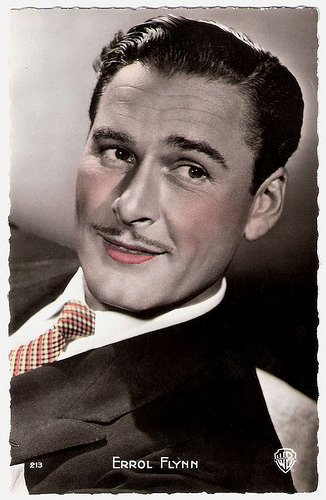
French postcard by Éditions P.I., Paris, no. 213. Photo: Warner Bros.
A parody of himself
In the 1950s, Errol Flynn became a parody of himself. He lost his savings from the Hollywood years in a series of financial disasters, including The Story of William Tell (Jack Cardiff, 1954) with Waltraut Haas . Aimlessly he sailed around the Western Mediterranean aboard his yacht Zaca. Heavy alcohol abuse left him prematurely aged and overweight.
He staved off financial ruin with roles in forgettable productions such as Hello God (William Marshall, 1951), Il maestro di Don Giovanni/Crossed Swords (Milton Krims, 1954) opposite Gina Lollobrigida , and King's Rhapsody (Herbert Wilcox, 1955) with Anna Neagle .
He performed in such also-ran Hollywood films as Mara Maru (Gordon Douglas, 1952) and Istanbul (Joseph Pevney, 1957) with Cornell Borchers , and made occasional television appearances. As early as 1952 he had been seriously ill with hepatitis resulting in liver damage. In 1956 he presented and sometimes performed in the television anthology series The Errol Flynn Theatre that was filmed in Britain.
He enjoyed a brief revival of popularity with The Sun Also Rises (Henry King, 1957), The Big Boodle (Richard Wilson, 1957), filmed in Cuba; Too Much, Too Soon (Art Napoleon, 1958), and The Roots of Heaven (John Huston, 1958) with Juliette Gréco . In these films he played drunks and washed out bums, and brought a poignancy to his performances that had not been there during his glamorous heydays.
He met with Stanley Kubrick to discuss a role in Lolita, but nothing came of it. Flynn went to Cuba in late 1958 to film the self-produced B film Cuban Rebel Girls (Barry Mahon, 1959), where he met Fidel Castro and was initially an enthusiastic supporter of the Cuban Revolution. He wrote a series of newspaper and magazine articles for the New York Journal American and other publications documenting his time in Cuba with Castro. Many of these pieces were lost until 2009, when they were rediscovered in a collection at the University of Texas at Austin's Center for American History. He narrated a short film titled Cuban Story: The Truth About Fidel Castro Revolution (1959), his last known work as an actor.
He published his autobiography, My Wicked Wicked Ways. In 1959, Errol Flynn died of a heart attack in Vancouver, Canada. Flynn was married three times. His first wife was actress Lily Damita (1935-1942). They had one son, actor and war correspondent Sean Flynn (1941-1971). Sean and his colleague Dana Stone disappeared in Cambodia in 1970, during the Vietnam War, while both were working as freelance photojournalists for Time magazine. It is generally assumed that they were killed by Khmer Rouge guerrillas.
Errol was married a second time to Nora Eddington from 1943 till 1949. They had two daughters, Deirdre (1945) and Rory (1947). His third wife was actress Patrice Wymore from 1950 until his death. They had one daughter, Arnella Roma (1953–1998). In 1980, author Charles Higham published a controversial biography, Errol Flynn: The Untold Story, in which he alleged that Flynn was a fascist sympathiser who spied for the Nazis before and during the Second World War, and that he was bisexual and had multiple gay affairs. Later Flynn biographers were critical of Higham's allegations, and found no evidence to corroborate them.
Original Trailer Captain Blood (1935). Source: TheTrailerGal (YouTube).
Trailer The Adventures of Robin Hood (1938). Source: Trailers, Sci, and/or Fi (YouTube).
Trailer The Roots of Heaven (1958). Source: saxondog2001 (YouTube).
Sources: (IMDb), Wikipedia and .

British postcard in the Picturegoer Series, no. 1301. Photo: Warner Bros.

British postcard by Art Photo, no. 92.
Pilfering petty cash
Errol Leslie Thomson Flynn was born in a suburb of Hobart, Tasmania, in 1909. His father, Theodore Flynn, was a lecturer and later professor of biology at the University of Tasmania. His mother was Lily Mary Young. After early schooling in Hobart, from 1923 to 1925 Flynn was educated at the South West London College, a private boarding school in Barnes, London.
In 1926 he returned to Australia to attend Sydney Church of England Grammar School (Shore School) where he was the classmate of a future Australian prime minister, John Gorton. His formal education ended with his expulsion from Shore for theft. After being dismissed from a job as a junior clerk with a Sydney shipping company for pilfering petty cash, he went to Papua New Guinea at the age of eighteen, seeking his fortune in tobacco planting and metals mining.
Flynn spent the next five years oscillating between the New Guinea frontier territory and Sydney. In early 1933, Flynn appeared as an amateur actor in the low-budget Australian film In the Wake of the Bounty (Charles Chauvel, 1933), in the lead role of Fletcher Christian.
Later that year he returned to Britain to pursue a career in acting, and soon secured a job with the Northampton Repertory Company at the town's Royal Theatre, where he worked and received his training as a professional actor for seven months. In 1934 Flynn was dismissed from Northampton Rep. reportedly after he threw a female stage manager down a stairwell.
He returned to Warner Brothers' Teddington Studios in Middlesex where he had worked as an extra in the film I Adore You (George King, 1933) before going to Northampton. With his new-found acting skills, he was cast as the lead in Murder at Monte Carlo (Ralph Ince, 1935), now considered a lost film. During its filming he was spotted by a talent scout for Warner Bros. and Flynn emigrated to the U.S. as a contract actor.

French postcard by Editions Chantal, Rueil-Malmaison, no. 8. Photo: Warner Bros. Publicity still for Another Dawn (William Dieterle, 1937).
Striking Good Looks
In Hollywood, Errol Flynn was first cast in two insignificant films, but then he got his great chance. He could replace Robert Donat in the title role of Captain Blood (Michael Curtiz, 1935). Flynn's natural athletic talent and good looks rocketed him overnight to international stardom.
Over the next six years, he was typecast as a dashing adventurer in The Charge of the Light Brigade (Michael Curtiz, 1936), The Prince and the Pauper (William Keighley, 1937), The Adventures of Robin Hood (Michael Curtiz, William Keighley, 1938; his first Technicolor film), The Dawn Patrol (Edmund Goulding, 1938) with David Niven , Dodge City (Michael Curtiz, 1939), The Private Lives of Elizabeth and Essex (Michael Curtiz, 1939) and The Sea Hawk (Michael Curtiz, 1940).
His striking good looks and screen charisma won him millions of fans. Flynn played an integral role in the re-invention of the action-adventure genre. In collaboration with Hollywood's best fight arrangers, Flynn became noted for fast-paced sword fights. He demonstrated an acting range beyond action-adventure roles in light contemporary social comedies, such as The Perfect Specimen (Michael Curtiz, 1937) and Four's a Crowd (Michael Curtiz, 1938), and melodrama The Sisters (Anatole Litvak, 1938).
During this period Flynn published his first book, Beam Ends (1937), an autobiographical account of his sailing experiences around Australia as a youth. He also travelled to Spain, in 1937, as a war correspondent during the Spanish Civil War.
Flynn co-starred with Olivia de Havilland a total of eight times, and together they made the most successful on-screen romantic partnership in Hollywood in the late 1930s-early 1940s in eight films. Flynn's relationship with Bette Davis, his co-star in The Private Lives of Elizabeth and Essex (Michael Curtiz, 1939), was quarrelsome. Davis allegedly slapped him across the face far harder than necessary during one scene.

Dutch postcard by M.B.&Z., no. 1050. Photo: Warner Bros.

German postcard by Edition Cicero, Hamburg, no. 150/10. Photo: Elmer Fryer, 1936 / The Kobal Collection.
Paragon of male physical prowess
In 1940, at the zenith of his career, Erroll Flynn was voted the fourth most popular star in the US. Flynn became a naturalised American citizen in 1942. As the United States had by then entered the Second World War, he attempted to enlist in the armed services, but failed the physical exam due to multiple heart problems and other diseases.
This created an image problem for both Flynn, the supposed paragon of male physical prowess, and for Warner Brothers, which continued to cast him in athletic roles, including such patriotic productions as Dive Bomber (Michael Curtiz, 1941), Desperate Journey (Raoul Walsh, 1942) and Objective, Burma! (Raoul Walsh, 1945).
His womanising lifestyle caught up with him in 1942 when two under-age girls, Betty Hansen and Peggy Satterlee, accused him of statutory rape at the Bel Air home of Flynn's friend Frederick McEvoy, and on board Flynn's yacht, respectively. The scandal received immense press attention. Many of Flynn's fans, assuming that his screen persona was a reflection of his actual personality, refused to accept that the charges were true. Flynn was acquitted, but the trial's widespread coverage and lurid overtones permanently damaged his carefully cultivated screen image as an idealised romantic leading player.
In 1946, Flynn published an adventure novel, Showdown, and earned a reported $184,000. In 1947 he signed a 15-year contract with Warner Bros. for $225,000 per film. After the Second World War, the taste of the American film going audience changed from European-themed material and the English history-based escapist epics in which Flynn excelled, to more gritty, urban realism and Film Noir, reflecting modern American life.
Flynn tried unsuccessfully to make the transition in Uncertain Glory (Raoul Walsh, 1944) with Paul Lukas , and Cry Wolf (Peter Godfrey, 1947) with Barbara Stanwyck, and then increasingly passé Westerns such as Silver River (Raoul Walsh, 1948) and Montana (Ray Enright, 1950). Flynn's behaviour became increasingly disruptive during filming; he was released from his contract in 1950 by Jack L. Warner as part of a stable-clearing of 1930s glamour-generation stars. His Hollywood career over at the age of 41, Flynn entered a steep financial and physical decline.

French postcard by Éditions P.I., Paris, no. 213. Photo: Warner Bros.
A parody of himself
In the 1950s, Errol Flynn became a parody of himself. He lost his savings from the Hollywood years in a series of financial disasters, including The Story of William Tell (Jack Cardiff, 1954) with Waltraut Haas . Aimlessly he sailed around the Western Mediterranean aboard his yacht Zaca. Heavy alcohol abuse left him prematurely aged and overweight.
He staved off financial ruin with roles in forgettable productions such as Hello God (William Marshall, 1951), Il maestro di Don Giovanni/Crossed Swords (Milton Krims, 1954) opposite Gina Lollobrigida , and King's Rhapsody (Herbert Wilcox, 1955) with Anna Neagle .
He performed in such also-ran Hollywood films as Mara Maru (Gordon Douglas, 1952) and Istanbul (Joseph Pevney, 1957) with Cornell Borchers , and made occasional television appearances. As early as 1952 he had been seriously ill with hepatitis resulting in liver damage. In 1956 he presented and sometimes performed in the television anthology series The Errol Flynn Theatre that was filmed in Britain.
He enjoyed a brief revival of popularity with The Sun Also Rises (Henry King, 1957), The Big Boodle (Richard Wilson, 1957), filmed in Cuba; Too Much, Too Soon (Art Napoleon, 1958), and The Roots of Heaven (John Huston, 1958) with Juliette Gréco . In these films he played drunks and washed out bums, and brought a poignancy to his performances that had not been there during his glamorous heydays.
He met with Stanley Kubrick to discuss a role in Lolita, but nothing came of it. Flynn went to Cuba in late 1958 to film the self-produced B film Cuban Rebel Girls (Barry Mahon, 1959), where he met Fidel Castro and was initially an enthusiastic supporter of the Cuban Revolution. He wrote a series of newspaper and magazine articles for the New York Journal American and other publications documenting his time in Cuba with Castro. Many of these pieces were lost until 2009, when they were rediscovered in a collection at the University of Texas at Austin's Center for American History. He narrated a short film titled Cuban Story: The Truth About Fidel Castro Revolution (1959), his last known work as an actor.
He published his autobiography, My Wicked Wicked Ways. In 1959, Errol Flynn died of a heart attack in Vancouver, Canada. Flynn was married three times. His first wife was actress Lily Damita (1935-1942). They had one son, actor and war correspondent Sean Flynn (1941-1971). Sean and his colleague Dana Stone disappeared in Cambodia in 1970, during the Vietnam War, while both were working as freelance photojournalists for Time magazine. It is generally assumed that they were killed by Khmer Rouge guerrillas.
Errol was married a second time to Nora Eddington from 1943 till 1949. They had two daughters, Deirdre (1945) and Rory (1947). His third wife was actress Patrice Wymore from 1950 until his death. They had one daughter, Arnella Roma (1953–1998). In 1980, author Charles Higham published a controversial biography, Errol Flynn: The Untold Story, in which he alleged that Flynn was a fascist sympathiser who spied for the Nazis before and during the Second World War, and that he was bisexual and had multiple gay affairs. Later Flynn biographers were critical of Higham's allegations, and found no evidence to corroborate them.
Original Trailer Captain Blood (1935). Source: TheTrailerGal (YouTube).
Trailer The Adventures of Robin Hood (1938). Source: Trailers, Sci, and/or Fi (YouTube).
Trailer The Roots of Heaven (1958). Source: saxondog2001 (YouTube).
Sources: (IMDb), Wikipedia and .
Published on November 11, 2016 22:00
November 10, 2016
EFSP's Dazzling Dozen: Bubble Gum Heroes
On a market I recently found a dozen of very small European collectors cards. They must date from the early 1950s and some are in colour and others in black and white. The formats also differ, as do the countries of origin. Of most the cards the origin is unclear, but some were produced as trading cards for bubble gum packets. Do you remember that pink chewing gum with which we could produce these giant bubbles? And now I do remember that in my time these sometimes included little pictures of pop stars. That was the 1960s when pop music and TV shows were all the rage among kids, but in the 1950s kids worshipped film stars.

Trevor Howard . Small Dutch collectors card for Klene's VAL Bubble Gum, no. 28.

Vivien Leigh . Small German collectors card. Photo: Warner Bros.

Ray Milland . Small German collectors card by Maple Leaf Canadian Chewing Gum, Wesel, no. 31. Photo: W.B.P.

Phyllis Calvert . Small vintage collectors card. Photo: Universal International.
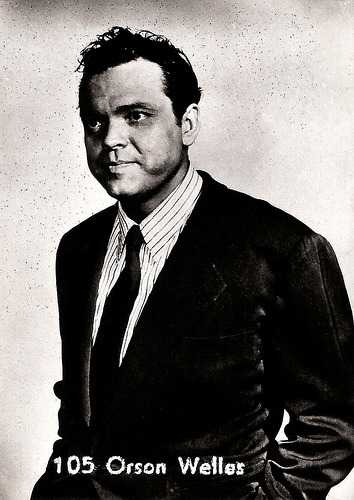
Orson Welles . Small Belgian collectors card by Belgian Chewing Gum Ltd., Antwerp, no. 105.
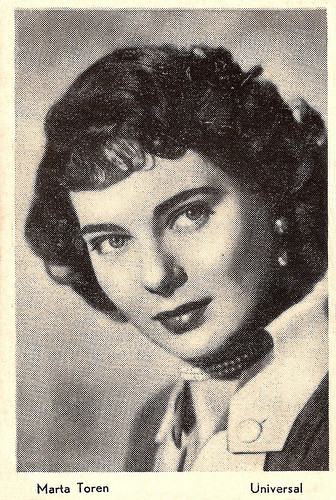
Marta Toren . Small vintage collectors card. Photo: Universal.
The history of Bubble Gum
In 1928, Walter E. Diemer, an accountant for the Fleer Chewing Gum Company in Philadelphia, was experimenting with new gum recipes. One recipe was found to be less sticky than regular chewing gum, and stretched more easily.
This gum became highly successful and was eventually named by the president of Fleer as Dubble Bubble because of its stretchy texture. The original bubble gum was pink in colour because that was the only dye Diemer had on hand at the time and it was his favourite colour.
In modern chewing gum, if natural rubber such as chicle is used, it must pass several purity and cleanliness tests. However, most modern types of chewing gum use synthetic gum based materials. These materials allow for longer-lasting flavor, a better texture, and a reduction in tackiness.
In 1996, Susan Montgomery Williams of Fresno, California set the Guinness World Record for largest bubblegum bubble ever blown, which was 26 inches or 66 cm in diameter.
Chewing gum was widely popular from the mid 20th century until a peak in 2009, after which sales began to decline. During the period between 2009 and 2013 sales of chewing gum fell 11 percent. And yes, I have to admit, nowadays I prefer candy like Smint.

Lex Barker . Small German collectors card, no. 85. Photo: Republic.

Joe E. Brown. Small vintage collectors card, no. C 28. Photo: Republic Pictures.
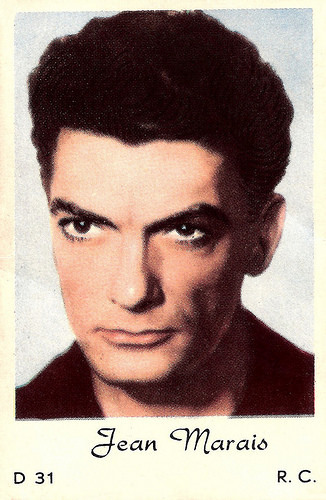
Jean Marais . Small vintage collectors card, no. D 31. Photo: R.C.

Hans Moser . Small vintage collectors card, no. Z 1.
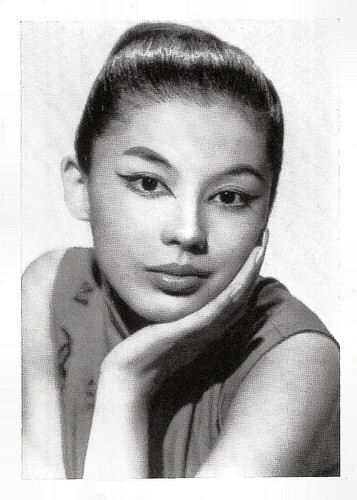
France Nuyen . Small vintage collectors card.

Claude Dauphin . Small collectors card, Serie D, no. 30. Photo: Warner Bros. Publicity still for April in Paris (David Butler, 1952).
This is a post for Postcard Friendship Friday, hosted by Beth at the The Best Hearts are Crunchy. You can visit her by clicking on the button below.

Source: Wikipedia.

Trevor Howard . Small Dutch collectors card for Klene's VAL Bubble Gum, no. 28.

Vivien Leigh . Small German collectors card. Photo: Warner Bros.

Ray Milland . Small German collectors card by Maple Leaf Canadian Chewing Gum, Wesel, no. 31. Photo: W.B.P.

Phyllis Calvert . Small vintage collectors card. Photo: Universal International.

Orson Welles . Small Belgian collectors card by Belgian Chewing Gum Ltd., Antwerp, no. 105.

Marta Toren . Small vintage collectors card. Photo: Universal.
The history of Bubble Gum
In 1928, Walter E. Diemer, an accountant for the Fleer Chewing Gum Company in Philadelphia, was experimenting with new gum recipes. One recipe was found to be less sticky than regular chewing gum, and stretched more easily.
This gum became highly successful and was eventually named by the president of Fleer as Dubble Bubble because of its stretchy texture. The original bubble gum was pink in colour because that was the only dye Diemer had on hand at the time and it was his favourite colour.
In modern chewing gum, if natural rubber such as chicle is used, it must pass several purity and cleanliness tests. However, most modern types of chewing gum use synthetic gum based materials. These materials allow for longer-lasting flavor, a better texture, and a reduction in tackiness.
In 1996, Susan Montgomery Williams of Fresno, California set the Guinness World Record for largest bubblegum bubble ever blown, which was 26 inches or 66 cm in diameter.
Chewing gum was widely popular from the mid 20th century until a peak in 2009, after which sales began to decline. During the period between 2009 and 2013 sales of chewing gum fell 11 percent. And yes, I have to admit, nowadays I prefer candy like Smint.

Lex Barker . Small German collectors card, no. 85. Photo: Republic.

Joe E. Brown. Small vintage collectors card, no. C 28. Photo: Republic Pictures.

Jean Marais . Small vintage collectors card, no. D 31. Photo: R.C.

Hans Moser . Small vintage collectors card, no. Z 1.

France Nuyen . Small vintage collectors card.

Claude Dauphin . Small collectors card, Serie D, no. 30. Photo: Warner Bros. Publicity still for April in Paris (David Butler, 1952).
This is a post for Postcard Friendship Friday, hosted by Beth at the The Best Hearts are Crunchy. You can visit her by clicking on the button below.

Source: Wikipedia.
Published on November 10, 2016 22:00
November 9, 2016
Leopoldine Konstantin
Leopoldine Konstantin (1886-1965) was a famous Austrian theatre and film character actress, who worked for years with director Max Reinhardt. She played Claude Rains' dominant mother in Alfred Hitchcock’s classic Notorious (1946). It was her sole Hollywood role.

German postcard by Verlag Hermann Leiser, no. 4310. Photo: Becker & Maass. Collection: Didier Hanson. The photo was a publicity still for Sumurûn (Max Reinhardt, 1910).

German postcard by Verlag Hermann Leiser, Berlin. Photo: Becker & Maass, Berlin. Publicity still for the play Fasching (Carnival).
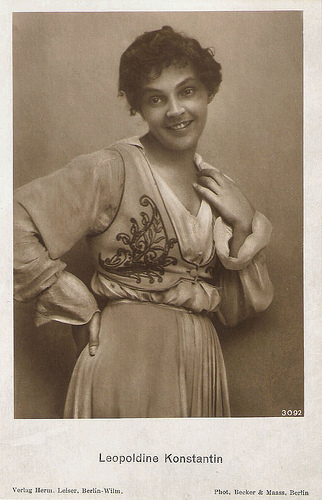
German postcard. by Verlag Hermann Leiser, Berlin. no. 3092. Photo: Becker & Maass, Berlin.
Max Reinhardt
Leopoldine Eugenie Amelie Konstantin was born in Brünn, Austria-Hungary (now Brno, Czech Republic) in 1886. She took acting lessons at the acting school of the Deutsches Theater with Alexander Strakosch, whom she married shortly afterwards in 1906. They had one son, Alexander.
In 1907, she made her stage debut at the Kammerspielen in Berlin, connected to Max Reinhardt’s Deutsches Theater in Berlin. She acted in small parts in such plays as Frank Wedekind's Frühlings Erwachen (Spring Awakening, 1907) and the William Shakespeare plays Romeo and Juliet (1907), A Winter's Tale (1908), and A Midsummer Night's Dream (1910).
She attracted the attention of the critics for the first time when she played Maria opposite Friedrich Kayssler in the drama Gawân: ein Mysterium (Gawan, 1910) by Eduard Stucken.
That year, she also made her first film appearance as a dancer in Max Reinhardt’s early silent film of the exotic dance pantomime Sumurûn (1910), featuring Bertha Wiesenthal. Konstantin became known in the Berlin salons, and in 1912 she moved to the Deutsches Theater. After a lawsuit with Max Reinhardt, she changed to Vienna in 1916.
In the cinema she initially played roles in such short silent films as Europäisches Sklavenleben/European slave life (Emil Justitz, 1912) with Friedrich Zelnik , the adventure film Die Insel der Seligen/The Island of the Blessed (Max Reinhardt, 1913) and the crime film Der Onyxknopf/The Onyx Head (Joe May, Hans Oberländer, 1917) with Max Landa as the detective Joe Deebs.
One of her best known performances during this period is her title role as Spanish dancer Lola Montez in the historical film Lola Montez (Robert Heymann, 1918) with Alfred Abel . After the First World War, she was offered increasingly minor parts, and she turned away from the cinema.
In 1919 she returned to the Berlin stages. In 1923 she had a house built in Westerland for herself and her son Alexander. The following year, she divorced Strakosch and married Hungarian counsellor and author Géza Herczeg. She was very successful in the title role in Friedrich Schiller's Maria Stuart (Mary Stuart) at the Volkstheater in Vienna in 1924. Another success was the play Finden Sie, dass sich Constanze richtig verhält? (1928).
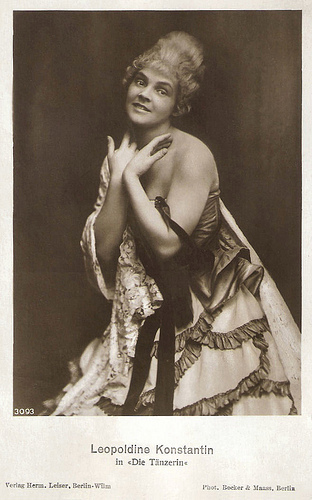
German postcard by Verlag Hermann Leiser, Berlin-Wilm., no. 3095. Photo: Becker & Maas, Berlin. Publicity still for Die Tänzerin/The Dancer (Georg Jacoby, 1915).

German postcard by Verlag Hermann Leiser, Berlin-Wilm., no. 8254. Photo: Becker & Maas, Berlin.
Spidery, tyrannical Nazi matron
From 1933 Leopoldine Konstantin returned to film work. She played a supporting part in the musical comedy Saison in Kairo/Season in Cairo (Reinhold Schünzel, 1933) starring Renate Müller and Willy Fritsch . She appeared at the side of Käthe von Nagy in the Ufa production Prinzessin Turandot/Princess Turandot (Gerhard Lamprecht, 1934).
Another success was the Prussian film Der alte und der junge König - Friedrichs des Grossen Jugend/The Old and the Young King (Hans Steinhoff, 1935) about the conflict between King Frederick William I of Prussia ( Emil Jannings ), loving only his army, and his young efficient son, who later became known as King Frederick the Great of Prussia (Werner Hinz). Konstantin played the queen, torn between her husband and son.
In 1935 she followed her husband Geza Herczeg to Austria and played among other things in the film Andere Welt/Other World (Marc Allégret, Alfred Stöger, 1937) with Käthe Gold . In Austria, she had also made the comedy Csibi, der Fratz/A Precocious Girl (Max Neufeld and Richard Eichberg, 1934), featuring Franciska Gaal and Konstantin as Cisbi’s mother.
The film was made by the German subsidiary of Universal Pictures. Because of the Nazi rise to power Gaal and other Jewish filmmakers went to Austria and Hungary to work on a series of comedy films. After the Anschluss of Austria with Nazi Germany, Konstantin's family moved to Britain where she lost her son during the last German air raid to London in 1944. Shortly after that she and Herczeg divorced (some sources say they divorced in 1938).
Then Konstantin went in exile in the United States. She spoke no English, and had to take a job as a factory worker. After intensive language study, she landed a supporting role in Alfred Hitchcock's film Notorious (1946). She played Nazi leader Claude Rains ' dominant and cold mother, although she was only 3 years older than he.
Wikipedia : “The final major casting decision was Mme. Sebastian, Alex's mother. The spidery, tyrannical Nazi matron demanded a stronger, older presence, and when attempts to obtain Ethel Barrymore and Mildred Natwick fell through, German actor Reinhold Schünzel suggested Leopoldine Konstantin (…). Notorious was Konstantin's only American film appearance and one of the unforgettable portraits in Hitchcock's films.”
On screen, Konstantin next only played small parts in a few American television series. IMDb quotes her about her role in Notorious (1946) and why she did not pursue further work in Hollywood: “My very first part and they made me in this monster!” In 1948 she returned to Vienna with her adopted daughter Elisabeth Herczeg, but she couldn't go on from her earlier successes. Her last acting work involved sporadic theatre roles and poetry readings on the radio.
Leopoldine Konstantin died in Hietzing near Vienna in 1965. She was 79.

German postcard by Photochemie, Berlin, no. K. 114. Photo: Alex Binder, Berlin. Collection: Didier Hanson.

German collectors card. Photo: RKO Radio Film. Publicity still for Notorious (Alfred Hitchcock, 1946) with Ingrid Bergman , Claude Rains and Leopoldine Konstantin.
Sources: Stephanie D’heil (Steffi-Line, German), Thomas Staedeli (Cyranos), Wikipedia (English and German), and .

German postcard by Verlag Hermann Leiser, no. 4310. Photo: Becker & Maass. Collection: Didier Hanson. The photo was a publicity still for Sumurûn (Max Reinhardt, 1910).

German postcard by Verlag Hermann Leiser, Berlin. Photo: Becker & Maass, Berlin. Publicity still for the play Fasching (Carnival).

German postcard. by Verlag Hermann Leiser, Berlin. no. 3092. Photo: Becker & Maass, Berlin.
Max Reinhardt
Leopoldine Eugenie Amelie Konstantin was born in Brünn, Austria-Hungary (now Brno, Czech Republic) in 1886. She took acting lessons at the acting school of the Deutsches Theater with Alexander Strakosch, whom she married shortly afterwards in 1906. They had one son, Alexander.
In 1907, she made her stage debut at the Kammerspielen in Berlin, connected to Max Reinhardt’s Deutsches Theater in Berlin. She acted in small parts in such plays as Frank Wedekind's Frühlings Erwachen (Spring Awakening, 1907) and the William Shakespeare plays Romeo and Juliet (1907), A Winter's Tale (1908), and A Midsummer Night's Dream (1910).
She attracted the attention of the critics for the first time when she played Maria opposite Friedrich Kayssler in the drama Gawân: ein Mysterium (Gawan, 1910) by Eduard Stucken.
That year, she also made her first film appearance as a dancer in Max Reinhardt’s early silent film of the exotic dance pantomime Sumurûn (1910), featuring Bertha Wiesenthal. Konstantin became known in the Berlin salons, and in 1912 she moved to the Deutsches Theater. After a lawsuit with Max Reinhardt, she changed to Vienna in 1916.
In the cinema she initially played roles in such short silent films as Europäisches Sklavenleben/European slave life (Emil Justitz, 1912) with Friedrich Zelnik , the adventure film Die Insel der Seligen/The Island of the Blessed (Max Reinhardt, 1913) and the crime film Der Onyxknopf/The Onyx Head (Joe May, Hans Oberländer, 1917) with Max Landa as the detective Joe Deebs.
One of her best known performances during this period is her title role as Spanish dancer Lola Montez in the historical film Lola Montez (Robert Heymann, 1918) with Alfred Abel . After the First World War, she was offered increasingly minor parts, and she turned away from the cinema.
In 1919 she returned to the Berlin stages. In 1923 she had a house built in Westerland for herself and her son Alexander. The following year, she divorced Strakosch and married Hungarian counsellor and author Géza Herczeg. She was very successful in the title role in Friedrich Schiller's Maria Stuart (Mary Stuart) at the Volkstheater in Vienna in 1924. Another success was the play Finden Sie, dass sich Constanze richtig verhält? (1928).

German postcard by Verlag Hermann Leiser, Berlin-Wilm., no. 3095. Photo: Becker & Maas, Berlin. Publicity still for Die Tänzerin/The Dancer (Georg Jacoby, 1915).

German postcard by Verlag Hermann Leiser, Berlin-Wilm., no. 8254. Photo: Becker & Maas, Berlin.
Spidery, tyrannical Nazi matron
From 1933 Leopoldine Konstantin returned to film work. She played a supporting part in the musical comedy Saison in Kairo/Season in Cairo (Reinhold Schünzel, 1933) starring Renate Müller and Willy Fritsch . She appeared at the side of Käthe von Nagy in the Ufa production Prinzessin Turandot/Princess Turandot (Gerhard Lamprecht, 1934).
Another success was the Prussian film Der alte und der junge König - Friedrichs des Grossen Jugend/The Old and the Young King (Hans Steinhoff, 1935) about the conflict between King Frederick William I of Prussia ( Emil Jannings ), loving only his army, and his young efficient son, who later became known as King Frederick the Great of Prussia (Werner Hinz). Konstantin played the queen, torn between her husband and son.
In 1935 she followed her husband Geza Herczeg to Austria and played among other things in the film Andere Welt/Other World (Marc Allégret, Alfred Stöger, 1937) with Käthe Gold . In Austria, she had also made the comedy Csibi, der Fratz/A Precocious Girl (Max Neufeld and Richard Eichberg, 1934), featuring Franciska Gaal and Konstantin as Cisbi’s mother.
The film was made by the German subsidiary of Universal Pictures. Because of the Nazi rise to power Gaal and other Jewish filmmakers went to Austria and Hungary to work on a series of comedy films. After the Anschluss of Austria with Nazi Germany, Konstantin's family moved to Britain where she lost her son during the last German air raid to London in 1944. Shortly after that she and Herczeg divorced (some sources say they divorced in 1938).
Then Konstantin went in exile in the United States. She spoke no English, and had to take a job as a factory worker. After intensive language study, she landed a supporting role in Alfred Hitchcock's film Notorious (1946). She played Nazi leader Claude Rains ' dominant and cold mother, although she was only 3 years older than he.
Wikipedia : “The final major casting decision was Mme. Sebastian, Alex's mother. The spidery, tyrannical Nazi matron demanded a stronger, older presence, and when attempts to obtain Ethel Barrymore and Mildred Natwick fell through, German actor Reinhold Schünzel suggested Leopoldine Konstantin (…). Notorious was Konstantin's only American film appearance and one of the unforgettable portraits in Hitchcock's films.”
On screen, Konstantin next only played small parts in a few American television series. IMDb quotes her about her role in Notorious (1946) and why she did not pursue further work in Hollywood: “My very first part and they made me in this monster!” In 1948 she returned to Vienna with her adopted daughter Elisabeth Herczeg, but she couldn't go on from her earlier successes. Her last acting work involved sporadic theatre roles and poetry readings on the radio.
Leopoldine Konstantin died in Hietzing near Vienna in 1965. She was 79.

German postcard by Photochemie, Berlin, no. K. 114. Photo: Alex Binder, Berlin. Collection: Didier Hanson.

German collectors card. Photo: RKO Radio Film. Publicity still for Notorious (Alfred Hitchcock, 1946) with Ingrid Bergman , Claude Rains and Leopoldine Konstantin.
Sources: Stephanie D’heil (Steffi-Line, German), Thomas Staedeli (Cyranos), Wikipedia (English and German), and .
Published on November 09, 2016 22:00
Paul van Yperen's Blog
- Paul van Yperen's profile
- 13 followers
Paul van Yperen isn't a Goodreads Author
(yet),
but they
do have a blog,
so here are some recent posts imported from
their feed.



